Mardi Gras Decoration
What Does King Cake Symbolize in Mardi Gras?

What exactly does King Cake symbolize during the lavish Mardi Gras festivities? The answer is more complex than one would assume.
As we explore the rich history and cultural significance of this traditional confection, we begin to uncover a tapestry of beliefs, customs, and rituals that have woven together to form the enigmatic symbol of the King Cake.
From its ancient roots to its modern-day manifestations, the story of the King Cake is a captivating journey that sheds light on the deep-seated traditions of Mardi Gras.
Key Takeaways
- King Cake symbolizes the unity of faiths and diversity of cultures, reflecting the cultural diversity of New Orleans and showcasing various influences.
- The colors of the King Cake (purple, green, and gold) represent the royal robes of the three kings and symbolize justice, faith, and power.
- The hidden trinket or baby figurine in the King Cake represents luck and prosperity and finding it makes one the 'king' or 'queen' of the celebration, fostering a sense of community and shared responsibility.
- The King Cake serves as a vibrant expression of cultural diversity, with modern interpretations and regional variations that incorporate elements from different cultures, reflecting the festival's historical roots and celebrating inclusivity.
Origins of King Cake
Where did the tradition of King Cake originate and how has it evolved over time?
The origins of King Cake can be traced back to the Middle Ages in France. Originally, it was associated with the Epiphany, a Christian holiday commemorating the visit of the Magi to the baby Jesus. The cake was meant to symbolize the three kings and was often adorned with three vibrant colors – purple, green, and gold, each representing justice, faith, and power, respectively.
Over time, the tradition spread to different cultures, each adding its own unique twist. In New Orleans, for example, the King Cake became closely associated with Mardi Gras, and a small figurine, or 'baby,' was added to symbolize luck and prosperity. The religious significance of the cake also evolved, with some seeing it as a representation of the unity of faiths and the diversity of cultures, especially as it's enjoyed in various celebrations around the world.
The cultural diversity surrounding King Cake has made it a symbol of inclusivity and joy, embodying the spirit of togetherness and celebration.
Religious Significance
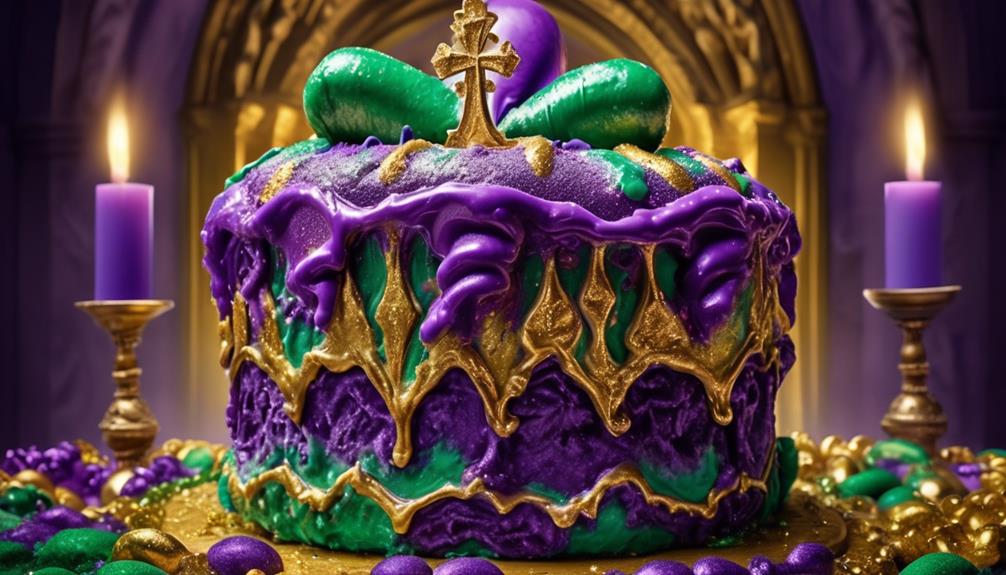
The evolution of the King Cake tradition from its origins in France to its association with Mardi Gras in New Orleans has brought about a rich and evolving religious significance, reflecting the unity of faiths and the diversity of cultures.
The religious symbolism associated with the King Cake holds deep spiritual significance, emphasizing the values of faith, community, and celebration.
- Unity of Faiths: The tradition of the King Cake transcends religious boundaries, symbolizing the coming together of diverse faiths in celebration and fellowship.
- Epiphany Celebration: The King Cake holds special significance in Christian traditions, symbolizing the arrival of the three wise men to visit the baby Jesus, marking the end of the Christmas season with joy and unity.
- Cultural Diversity: The King Cake reflects the cultural diversity of New Orleans, with its roots in European traditions and its adaptation into the vibrant tapestry of Mardi Gras, showcasing the harmony of various cultural and religious influences.
The King Cake's religious significance speaks to the universal themes of togetherness and spiritual celebration, making it an integral part of the Mardi Gras festivities and a symbol of shared joy and reverence.
Three Kings and Epiphany
Celebrating the arrival of the three wise men, the King Cake tradition intertwines religious symbolism with the joyous spirit of Mardi Gras in New Orleans.
The connection between the King Cake and the Three Kings is deeply rooted in the Christian faith and the celebration of Epiphany. Epiphany, also known as Three Kings' Day, commemorates the visit of the Magi to the infant Jesus, representing the revelation of Christ to the Gentiles. In many cultures, this day is marked by various customs and traditions, one of which is the sharing of a special cake, symbolizing the search for the baby Jesus by the three kings.
In New Orleans, the King Cake holds a significant place in the Epiphany celebration. The cake's circular shape represents the unity of faith and the continuous journey of the three kings. The colors of the cake – purple, green, and gold – are a nod to the royal robes of the three kings.
As we indulge in the sweet, cinnamon-infused cake, we honor the legacy of the three kings and the profound meaning behind the Epiphany celebration.
Seasonal Tradition
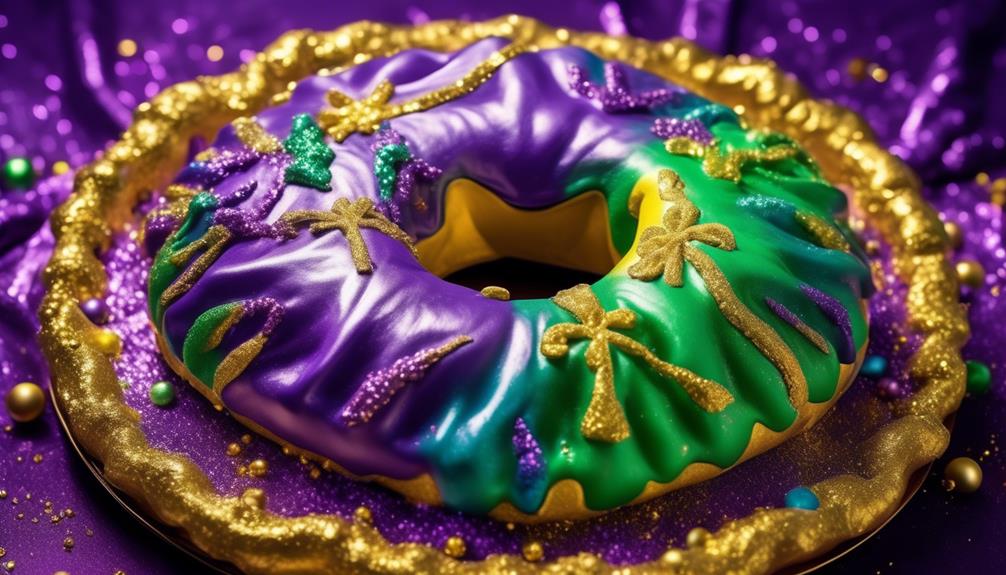
As we celebrate Mardi Gras, the seasonal tradition of King Cake holds deep cultural significance and religious associations for many.
The decorative elements of the cake aren't just for show; they carry symbolic meanings that have been passed down through generations. From the vibrant colors to the hidden trinkets, each aspect of the King Cake tells a story of tradition and celebration.
Cultural Significance
Embracing the vibrant colors and rich flavors, Mardi Gras season brings communities together to indulge in the time-honored tradition of King Cake. This cultural tradition holds a deep significance in Southern Louisiana, where it's intricately woven into the fabric of celebration customs.
- The joyous act of sharing a King Cake fosters a sense of unity and togetherness, symbolizing the communal spirit of Mardi Gras.
- The hidden trinket or baby figurine within the cake represents luck and prosperity, adding an element of excitement and anticipation to the festivities.
- The traditional colors of the King Cake – purple, green, and gold – reflect values of justice, faith, and power, reminding us of the deeper meanings behind the revelry.
As we partake in this cherished custom, we not only savor the delectable treat but also honor the cultural heritage and collective joy it embodies.
Religious Associations
During the Mardi Gras season, the King Cake serves as a tangible representation of religious associations, intertwining the cultural festivities with the sacred traditions of faith and renewal. The King Cake's religious symbolism is deeply rooted in the Christian faith, specifically symbolizing the Epiphany, also known as Three Kings' Day, which celebrates the visit of the Magi to the baby Jesus. This tradition reflects the cultural diversity of Mardi Gras, as different variations of the King Cake are found in various countries, each with its own religious significance. In addition to its ties to the Epiphany, the three colors of the King Cake – purple, green, and gold – hold religious symbolism: purple for justice, green for faith, and gold for power. This representation of religious beliefs within the King Cake further enriches the cultural tapestry of Mardi Gras.
| Religious Associations | Cultural Diversity | Symbolism |
|---|---|---|
| Epiphany celebration | Various country variations | Purple, green, and gold colors |
Decorative Elements
The religious symbolism of the King Cake seamlessly intertwines with its decorative elements, infusing the Mardi Gras season with vibrant colors and ornate designs that symbolize the festivity's seasonal tradition.
The decorative traditions associated with King Cake evoke a sense of joy and celebration, with its bright hues and intricate patterns capturing the essence of the Mardi Gras spirit.
The festive symbolism embedded in the cake's decorations fosters a feeling of anticipation and excitement, as each ornamental detail reflects the rich history and cultural significance of the Mardi Gras tradition.
The elaborate and whimsical designs on the cake convey a sense of tradition, community, and merriment, creating an atmosphere of warmth and togetherness that's central to the Mardi Gras experience.
Decorative Elements
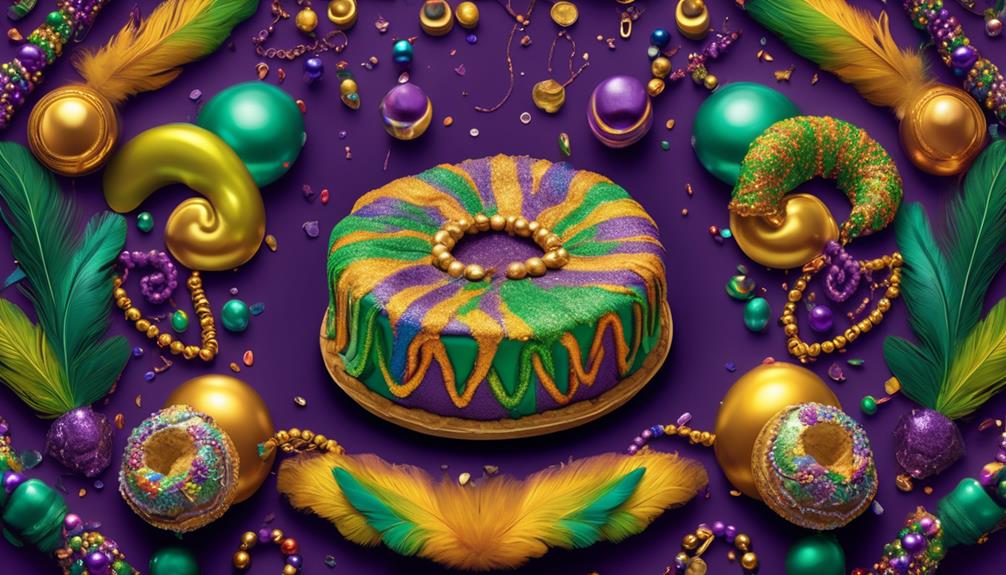
When it comes to King Cakes, the decorative elements play a crucial role in capturing the spirit of Mardi Gras. The vibrant colors and intricate designs of the cake symbolize the festive and joyous atmosphere of the celebration.
Additionally, the tradition of hiding a trinket within the cake adds an element of surprise and excitement to the entire experience.
Colors and Designs
Adorning the traditional King Cake are vibrant and symbolic colors, such as purple, green, and gold, accompanied by intricate designs, all of which hold deep significance in Mardi Gras celebrations. These colors and designs aren't just decorative elements but are deeply rooted in the history and traditions of Mardi Gras.
Here's a closer look at what they symbolize:
- Purple: Represents justice and signifies the quest for justice in society.
- Green: Symbolizes faith and reflects the importance of faith in the community.
- Gold: Signifies power and highlights the strength and resilience of the community.
The traditional designs, often featuring crowns, fleur-de-lis, and masks, add an air of regality and mystery to the cake, further enhancing the festive spirit of Mardi Gras. These elements come together to create a visually stunning and culturally rich symbol of the Mardi Gras tradition.
Hidden Trinket Tradition
Exploring the intricate and symbolic decorative elements of the King Cake, we uncover the fascinating tradition of the hidden trinket, adding an element of surprise and excitement to the Mardi Gras festivities.
The hidden trinket, often a tiny plastic baby, represents the baby Jesus and symbolizes luck and prosperity.
As per traditional customs, whoever finds the trinket in their slice of cake is deemed the 'king' or 'queen' of the celebration and is responsible for hosting the next social gathering or providing the King Cake.
This playful custom fosters a sense of community and shared responsibility, enhancing the joyful and communal spirit of Mardi Gras.
It's a delightful tradition that brings an extra layer of fun and anticipation to the already vibrant and lively festivities.
Hidden Trinket Tradition
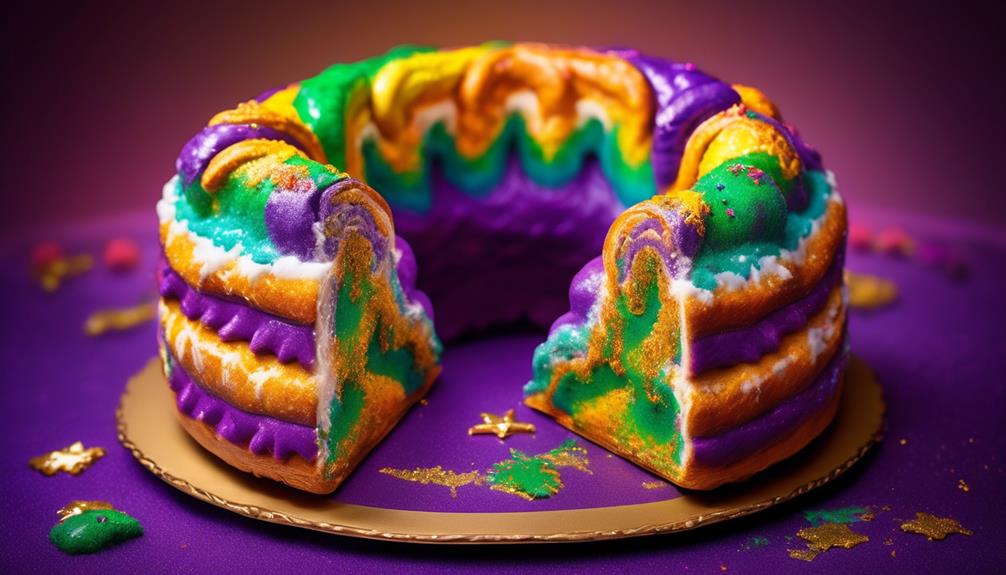
Delving into the King Cake tradition reveals the intriguing and cherished custom of hiding a trinket within its sweet layers, adding an element of surprise and excitement to the Mardi Gras celebration.
The hidden trinket tradition evokes a sense of anticipation and camaraderie, as friends and family gather around the cake, eagerly awaiting the moment when the lucky recipient discovers the hidden treasure.
It fosters a feeling of unity and shared joy, as everyone partakes in the thrill of uncovering the hidden trinket, symbolizing good fortune and prosperity for the coming year.
The tradition also sparks friendly competition and playful banter as each person hopes to be the fortunate finder of the trinket, creating an atmosphere filled with laughter and lighthearted suspense.
Additionally, the act of concealing a trinket within the cake reflects the essence of Mardi Gras, where revelers come together to share in the revelry and merriment, reinforcing the spirit of togetherness and communal celebration.
Symbol of Unity
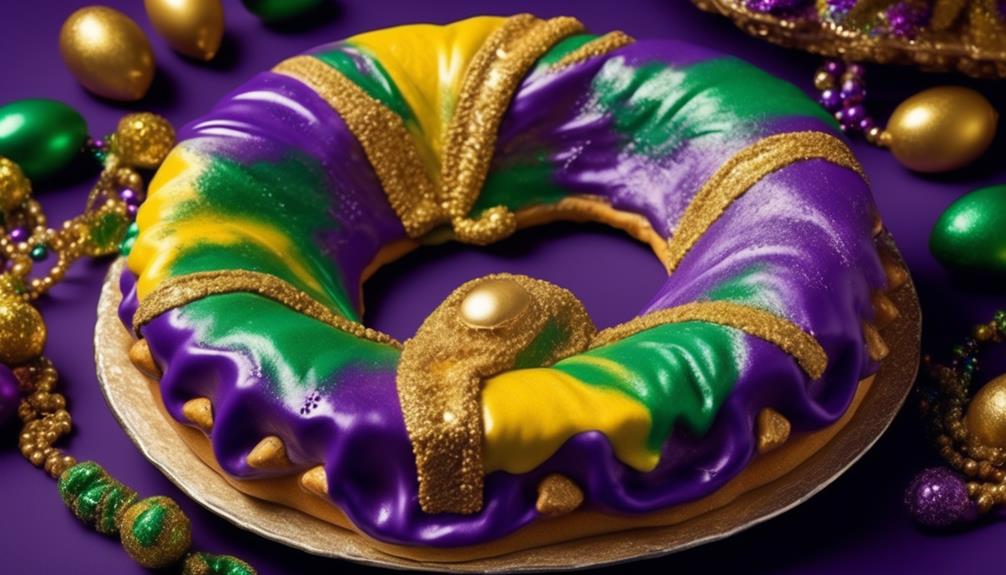
As we savor the delectable King Cake during Mardi Gras, it serves as a powerful symbol of unity that transcends cultural diversity.
The vibrant colors and diverse flavors of the cake mirror the rich tapestry of the community coming together in communal celebration.
This cherished tradition not only unites us in joyous revelry but also reinforces the bonds of togetherness and inclusivity.
Cultural Diversity
Symbolizing the rich tapestry of cultures that come together to celebrate Mardi Gras, the King Cake stands as a unifying emblem of cultural diversity, embodying the spirit of unity and togetherness.
The King Cake reflects the diverse culinary traditions brought by different cultural groups, from the French influence in its flaky pastry to the Spanish and Latin American infusion of vibrant colors and flavors.
It represents the harmony and inclusivity found in community celebrations, where people from all walks of life join in the festivities, regardless of their cultural backgrounds.
The King Cake also serves as a reminder of the interconnectedness of humanity, showcasing how cultural diversity enriches our lives and brings us closer together, creating a shared experience that transcends individual differences.
Communal Celebration
Coming together in a joyous and communal celebration, the King Cake serves as a unifying symbol of unity during Mardi Gras festivities. As we gather in celebratory gatherings, the act of sharing this delectable pastry fosters a sense of community bonding.
The tradition of hiding a tiny trinket or figurine, such as a plastic baby, within the cake embodies the spirit of togetherness. As we eagerly partake in the cake, the anticipation of who'll discover the hidden token creates an atmosphere of shared excitement and camaraderie.
This communal custom emphasizes the interconnectedness of our revelry, transcending individual differences and fostering a sense of belonging. The King Cake, with its vibrant colors and rich flavors, symbolizes our collective joy and solidarity, making it an essential part of the Mardi Gras tradition.
Social and Cultural Customs
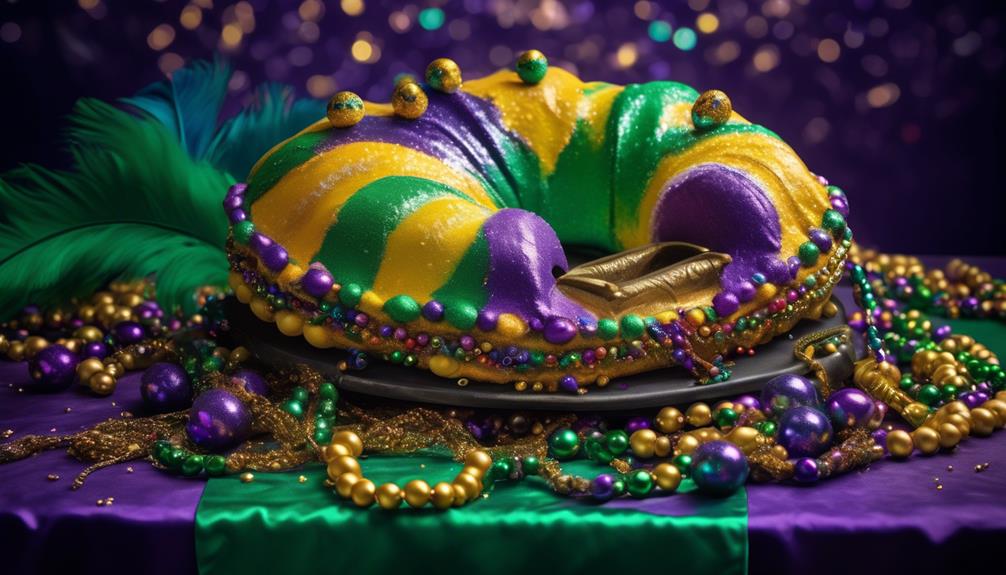
The vibrant colors, intricate designs, and hidden surprise of the King Cake embody the rich tapestry of social and cultural customs celebrated during Mardi Gras. From the moment the cake is brought into a room, there's an undeniable sense of anticipation and excitement that fills the air.
The act of sharing the cake with others reinforces the spirit of togetherness and unity, as it symbolizes the coming together of friends, family, and even strangers in celebration.
The tradition of hiding a small trinket, often a tiny plastic baby, within the cake creates an element of surprise and joy, representing the unexpected delights that life has to offer.
The custom of crowning the person who finds the trinket as the 'king' or 'queen' for the day adds an element of lighthearted playfulness and reinforces the idea of fostering strong, supportive communities.
The act of sharing and consuming the King Cake fosters a sense of camaraderie and shared experience, strengthening the bonds between individuals and communities.
These customs and traditions surrounding the King Cake serve as a beautiful reflection of the social and cultural values cherished during Mardi Gras, emphasizing the importance of unity, joy, and coming together as a community.
Evolution of King Cake
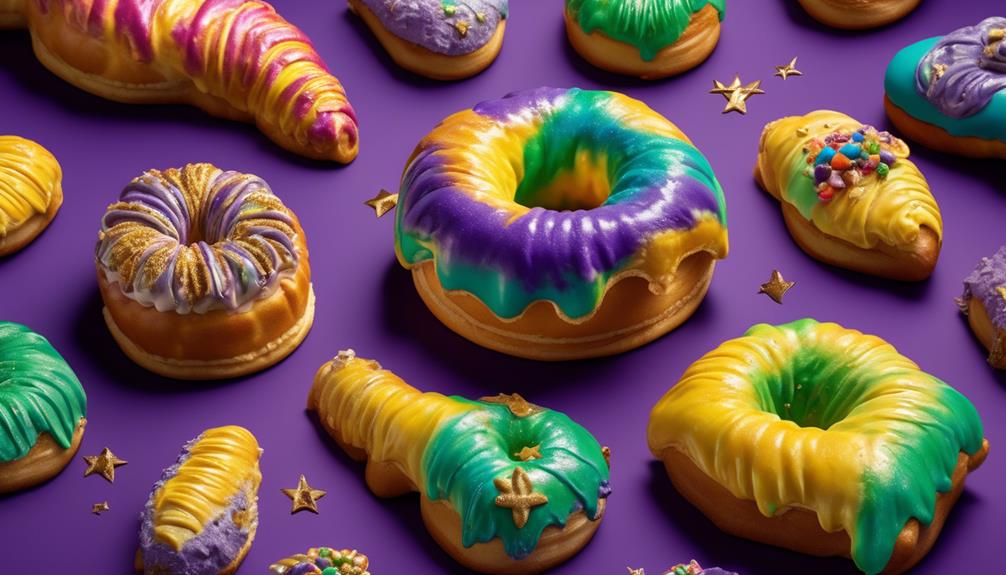
As we explore the evolution of King Cake, we witness how this beloved symbol of togetherness and surprise has transformed over time, reflecting the dynamic nature of Mardi Gras traditions. The evolution of King Cake has seen a blend of traditional elements with modern influences, creating a confectionery delight that continues to captivate and enthrall. Let's take a closer look at the evolution of King Cake through the years:
| Traditional Elements | Evolutionary Changes | Modern Influences |
|---|---|---|
| Circular Shape | Addition of Fillings | Unique Flavor Profiles |
| Hidden Trinket | Variety of Trinkets | Customized Surprises |
| Purple, Green, Gold | Diverse Color Palettes | Trendy Decorations |
| Religious Significance | Inclusion of Non-Religious Elements | Secular Celebrations |
The traditional elements of the circular shape, hidden trinket, vibrant colors, and religious significance have evolved to embrace a wider range of fillings, trinkets, colors, and even non-religious elements, catering to diverse tastes and preferences. This evolution ensures that the King Cake remains a timeless symbol of joy and community, uniting people in the spirit of celebration.
Modern Interpretations
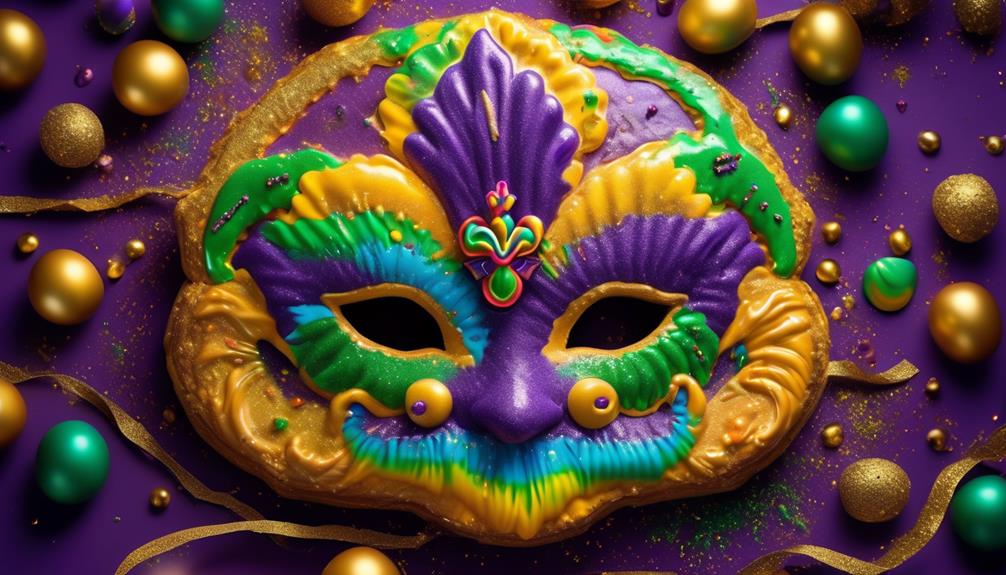
As we explore modern interpretations of the King Cake, we uncover the intricate symbolism behind the cake decorations, representing various cultural elements and traditions.
The cake serves as a vibrant expression of cultural diversity, reflecting the rich tapestry of Mardi Gras celebrations.
Moreover, the act of sharing the King Cake fosters a sense of communal joy and togetherness, making it a cherished tradition in today's festive gatherings.
Symbolic Cake Decorations
Incorporating vibrant colors and whimsical designs into the cake decorations adds a modern flair to the traditional symbolism of the King Cake. Modern interpretations of King Cake decorations reflect the joyful spirit of Mardi Gras, infusing the cake with symbolism and creativity.
Here are some evocative examples:
- Delicate fleur-de-lis motifs that symbolize royalty and heraldry, adding an air of elegance to the cake.
- Multi-colored sugar sprinkles representing the diverse and vibrant community that comes together to celebrate Mardi Gras.
- Edible gold leaf accents, signifying the hidden treasure of the baby figurine and the rewards of finding it in the King Cake.
These contemporary decorations not only enhance the visual appeal of the King Cake but also deepen the meaning behind its symbolism, making it a truly captivating centerpiece for Mardi Gras celebrations.
Cultural Diversity Representation
Embracing the rich tapestry of cultures, modern interpretations of King Cake decorations infuse the traditional symbolism with vibrant representations of cultural diversity. The evolving nature of Mardi Gras celebrations has sparked a beautiful shift towards cultural appreciation, inclusion, and unity. King Cakes now feature a diverse array of decorations that reflect the melting pot of traditions and people that make Mardi Gras so special. From intricate patterns inspired by African textiles to vibrant colors reminiscent of Indian festivals, the King Cake has become a canvas for celebrating cultural richness. Below is a visual representation of how modern King Cake decorations incorporate cultural diversity:
| Cultural Representation | Description | Symbolism |
|---|---|---|
| African Textiles | Bold, intricate patterns | Unity and strength in diversity |
| Indian Festivals | Vibrant colors | Celebration and inclusivity |
| European Heritage | Classic symbols | Acknowledgment of the festival's historical roots |
Festive Communal Tradition
With the passage of time, the communal tradition of Mardi Gras has evolved to encompass a vibrant array of modern interpretations, reflecting the dynamic spirit of celebration and unity.
In today's festivities, the festive traditions of Mardi Gras are celebrated through:
- Colorful Parades: The streets come alive with vibrant floats, music, and dance, showcasing the rich cultural tapestry of the community.
- Community Gatherings: People from all walks of life come together to share in the joyous revelry, strengthening the bonds of friendship and unity.
- Culinary Delights: Traditional King Cakes, adorned with the iconic purple, green, and gold colors, are shared among friends and family, symbolizing the spirit of togetherness and celebration.
These modern interpretations of Mardi Gras festivities not only honor the traditional roots but also infuse the celebrations with a renewed sense of community and togetherness.
Regional Variations

How do different regions in the United States put their own unique spin on the traditional King Cake for Mardi Gras celebrations?
Regional variations in King Cake recipes add a delightful twist to this Mardi Gras tradition.
In Louisiana, the birthplace of the American King Cake, the confection is typically a ring of twisted cinnamon dough topped with icing or sugar in the Mardi Gras colors of purple, green, and gold, symbolizing justice, faith, and power.
However, move to the Gulf Coast, and you might find variations with cream cheese or fruit fillings. In Texas, some bakers add a Texan touch by incorporating pecans or even a hint of chili powder for a spicy kick.
In the Midwest, particularly in places with strong Scandinavian heritage like Minnesota, King Cakes resemble more of a coffee cake, often filled with almond paste and topped with a simple glaze.
These regional adaptations showcase the diversity and creativity of American communities, each infusing the traditional recipe with local flavors and cultural influences.
King Cake Parties

As we gather to celebrate Mardi Gras, King Cake parties bring friends and family together to enjoy this festive tradition. At these joyous gatherings, we embrace the rich history and traditions of Mardi Gras through our King Cake parties.
Here are a few key elements that make these celebrations truly special:
- Party themes that celebrate the traditional colors of Mardi Gras — purple, green, and gold — infuse the atmosphere with a vibrant and whimsical energy. From masquerade balls to jazz-themed soirees, these parties offer a creative canvas for revelers to express their festive spirits.
- Social gatherings filled with laughter and camaraderie create a warm and welcoming environment. As we indulge in slices of King Cake, the anticipation of finding the hidden trinket or bean adds an exhilarating element to these gatherings, fostering a sense of playful competition and shared excitement.
- Sweet treats that tantalize our taste buds with delectable flavors and textures. The sweet, cinnamon-infused dough, adorned with colorful icing and sugar, creates a sensory delight that elevates the festive mood, making each bite a moment to savor.
Role in Mardi Gras Festivities
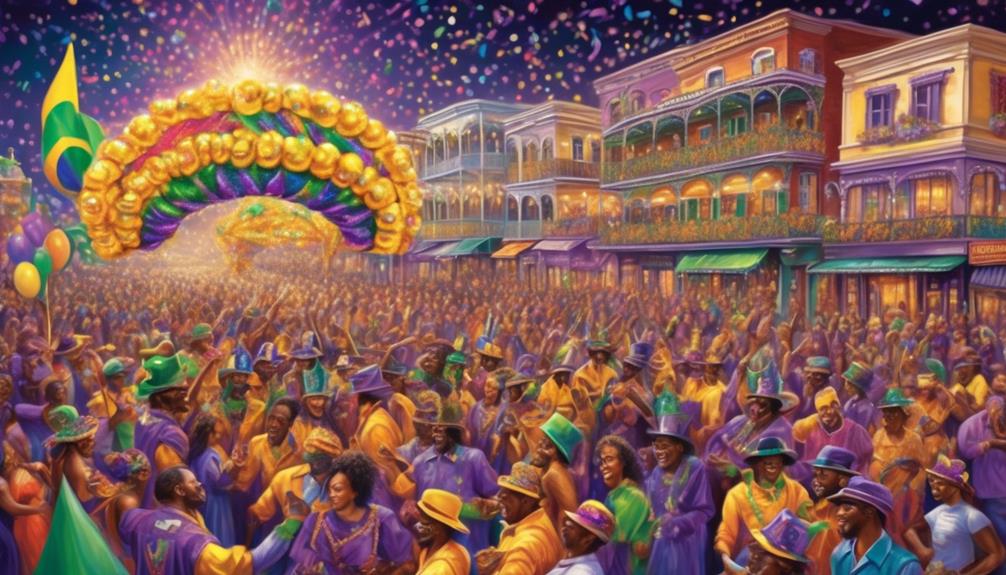
King Cake plays a central role in Mardi Gras festivities, adding a sense of anticipation and tradition to the lively celebrations. The cake itself is a focal point of the Mardi Gras season, contributing to the joyous and communal atmosphere that defines this traditional festival. It serves as a symbol of coming together, sharing, and reveling in the rich culture and history of the event.
| Role of King Cake in Mardi Gras | Traditional Festivities in Mardi Gras |
|---|---|
| Symbolizes community and togetherness | Parades and street parties |
| Marks the beginning of the Mardi Gras season | Music, dancing, and colorful costumes |
| Involves a fun and interactive tradition with the hidden trinket | Indulgence in rich, delicious Creole and Cajun cuisine |
The role of the King Cake in Mardi Gras goes beyond being just a dessert. It embodies the spirit of unity and conviviality that defines the traditional festivities in Mardi Gras. As we eagerly anticipate the arrival of Mardi Gras each year, the King Cake serves as a delicious reminder of the joyous celebrations and the sense of community that unites us during this vibrant and culturally significant time.
King Cake in Popular Culture
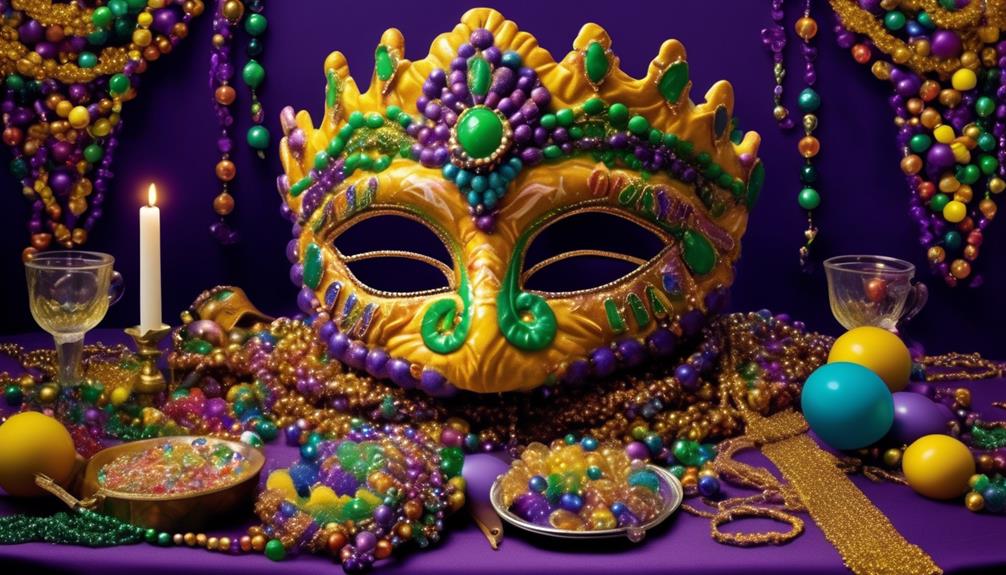
Delving into the cultural tapestry of New Orleans, the King Cake takes on a prominent role in contemporary society, weaving its way into music, art, and culinary traditions. This delectable treat has become a symbol of community and celebration, inspiring various forms of artistic expression and cultural appreciation.
- Jazz melodies infuse the air with the sweet aroma of King Cake during Mardi Gras, creating a harmonious blend of music and tradition.
- Local artists capture the essence of King Cake in vibrant paintings, depicting the rich history and festive spirit associated with this beloved confection.
- Chefs and home bakers alike continue to honor the traditional recipe of King Cake, preserving its heritage and ensuring that each bite carries the legacy of New Orleans' culinary prowess.
From its intriguing king cake history to the time-honored traditional recipe, the King Cake has transcended its culinary origins to become a cherished emblem of New Orleans' vibrant culture. Its presence in popular culture serves as a testament to the enduring allure and significance of this beloved pastry.
Frequently Asked Questions
How Did the Tradition of Hiding a Baby Figurine in the King Cake Begin?
We love the story of how the tradition of hiding a baby figurine in the king cake began. Its origin is rooted in the cultural significance of Mardi Gras.
The baby symbolizes luck and prosperity, and finding it brings good fortune. This playful tradition adds an element of surprise and excitement to the festivities, creating an atmosphere of joy and celebration.
It's a delightful way to honor the spirit of Mardi Gras.
Are There Any Health or Dietary Restrictions Associated With King Cake Consumption During Mardi Gras?
Indulging in the delectable King Cake during Mardi Gras is a cherished tradition, but it's important to consider health and dietary restrictions. Some may have allergies or dietary needs, so it's essential to be mindful of the ingredients.
The cultural significance of the King Cake is deeply rooted in traditional practices, symbolizing unity and celebration. Like a colorful carnival, it brings people together.
However, it's crucial to ensure that everyone can partake in the festivities.
What Are Some Unique Regional Variations of King Cake That Are Not Commonly Known?
Regional ingredients and cultural significance make each king cake unique.
In Louisiana, you'll find the traditional cinnamon-filled cake, while in France, they use almond cream. In Spain, they add fruits and nuts, giving it a different twist. These variations reflect the diverse influences on Mardi Gras traditions.
The regional touch adds a special flavor to the celebrations, making each king cake experience a delightful exploration of culture and taste.
How Has the Symbolism of the King Cake Evolved Over Time, Particularly in Modern Interpretations?
Over time, the symbolism of the king cake has evolved, taking on new layers of cultural significance. Its modern interpretations reflect a fusion of traditions, capturing the essence of community and celebration.
The evolution of symbolism in the king cake mirrors our changing perspectives on unity and festivity. Its cultural significance has deepened, weaving together diverse influences and creating a rich tapestry of meaning that resonates with people from all walks of life.
Are There Any Famous or Notable Instances of King Cake Being Incorporated Into Popular Culture or Media?
We've come across some fascinating instances of king cake making its mark in popular culture. From being featured in movies to inspiring songs, this iconic treat has found its way into the heart of entertainment.
In movies, we've seen characters indulging in the joy of king cake, adding a touch of Mardi Gras flavor to the scenes.
Likewise, musicians have embraced the festive spirit by incorporating king cake references in their music, celebrating this beloved tradition.
Conclusion
In conclusion, King Cake holds a special place in Mardi Gras festivities, symbolizing the arrival of the Three Kings and the beginning of the carnival season.
Did you know that over 750,000 King Cakes are consumed in New Orleans during the Mardi Gras season?
It's a delicious and festive tradition that brings people together to celebrate and indulge before the Lenten season begins.
- About the Author
- Latest Posts
Introducing Ron, the home decor aficionado at ByRetreat, whose passion for creating beautiful and inviting spaces is at the heart of his work. With his deep knowledge of home decor and his innate sense of style, Ron brings a wealth of expertise and a keen eye for detail to the ByRetreat team.
Ron’s love for home decor goes beyond aesthetics; he understands that our surroundings play a significant role in our overall well-being and productivity. With this in mind, Ron is dedicated to transforming remote workspaces into havens of comfort, functionality, and beauty.
Mardi Gras Decoration
What Are the Rules for a Table Centerpiece?
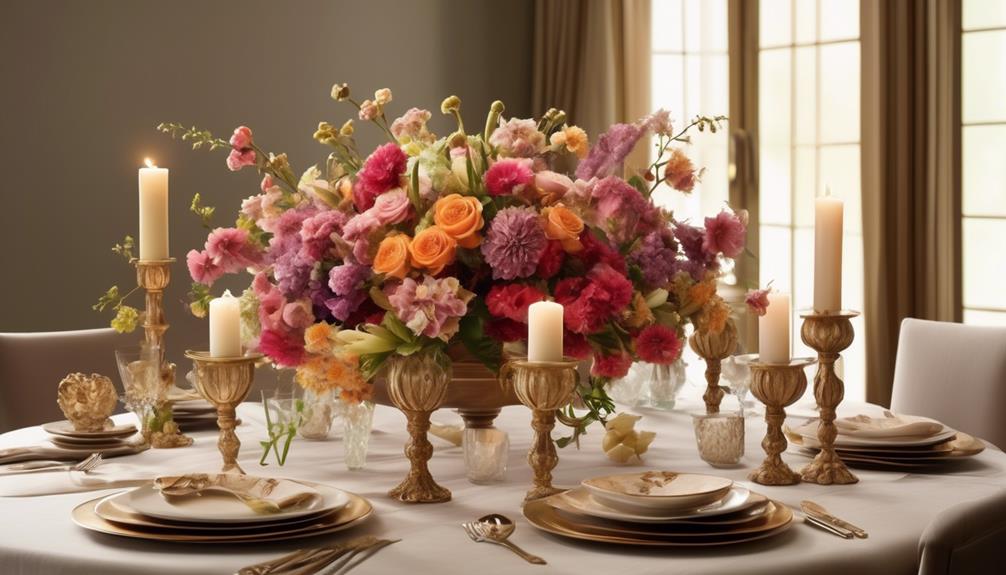
Have you ever thought about what makes a table centerpiece really special? The guidelines for a table centerpiece may seem hard to pin down, but don’t worry, because we have the inside track on how to create the ideal focal point for your dining table.
From proportion and scale to color harmony and seasonal considerations, there are several key factors to consider. But how do you strike the balance between elegance and practicality?
Stay tuned to discover the secrets that will elevate your table decor to the next level.
Key Takeaways
- Floral arrangements should complement the table and surrounding space, taking into account proportion, scale, and visual impact.
- Consider color harmony and theme when selecting flowers and decorative elements for the centerpiece.
- Choose a centerpiece that complements the shape and size of the table, taking into consideration height and proportions.
- Prioritize practicality and functionality by selecting a centerpiece that does not obstruct the view or limit space for tableware and food.
Proportion and Scale
When creating a table centerpiece, it's important to ensure that the proportion and scale of the elements work harmoniously together to create a visually appealing arrangement. Floral arrangements play a crucial role in achieving this balance. The size and shape of the flowers should complement the dimensions of the table and the surrounding space.
For instance, tall and elaborate floral arrangements might overwhelm a small table, while petite bouquets could get lost on a large table. It's all about finding that sweet spot where the floral elements enhance the overall aesthetic without dominating the scene.
In addition to floral arrangements, decorative elements also contribute to the proportion and scale of the centerpiece. Incorporating items like candles, greenery, or decorative figurines can add depth and visual interest. However, it's essential to strike a balance and not overcrowd the centerpiece. Each element should have enough room to shine without competing for attention.
Ultimately, achieving the right proportion and scale in a table centerpiece creates a captivating focal point that brings warmth and intimacy to any gathering.
Color Harmony
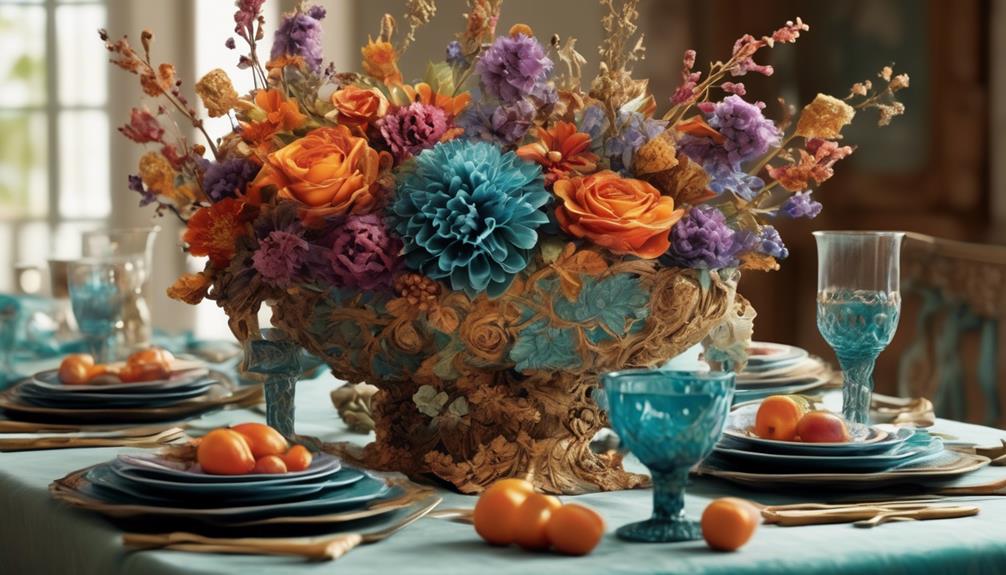
Our centerpiece's color harmony should reflect the overall theme and ambiance of the event, ensuring a cohesive and visually pleasing composition. When considering color combinations for a table centerpiece, it's essential to strike a balance in the design to create a harmonious and appealing look.
We want to ensure that the colors chosen complement each other and enhance the overall aesthetic of the table setting. Whether we opt for a monochromatic scheme for a clean and sophisticated look, or a complementary color palette for a vibrant and dynamic feel, the key is to maintain design balance. By incorporating different hues and tones that work well together, we can achieve a cohesive and visually striking centerpiece that captures the essence of the event.
Additionally, we should consider the impact of the centerpiece within the larger context of the room, ensuring that the color harmony contributes to the overall atmosphere. Ultimately, a well-planned color scheme for our centerpiece can elevate the entire table setting, leaving a lasting impression on our guests.
Seasonal Considerations
When it comes to table centerpieces, considering the season is crucial. We need to think about using seasonal flowers, incorporating holiday themes, and coordinating colors to match the time of year.
These elements can help create a cohesive and impactful centerpiece that complements the overall theme and atmosphere of the event.
Seasonal Flowers
In selecting seasonal flowers for table centerpieces, we consider the availability and vibrancy of blooms during specific times of the year. When choosing seasonal flowers, keep in mind:
- Color Palette: Opt for flowers that complement the season's color scheme, such as warm tones for fall and bright hues for summer.
- Fragrance: Select blooms with captivating scents to enhance the ambiance of the event and create a delightful sensory experience.
- Durability: Choose flowers that can withstand the seasonal conditions and last throughout the event, ensuring a long-lasting and visually appealing centerpiece.
Considering these factors ensures that your table centerpiece not only reflects the season's essence but also captivates and delights your guests.
Holiday Themes
As we approach the holiday season, we carefully consider the festive themes and seasonal elements to create captivating table centerpieces. Festive arrangements play a crucial role in setting the mood for holiday gatherings.
Incorporating decorative accents like miniature ornaments, twinkling lights, or seasonal figurines adds a touch of whimsy and charm to the table centerpiece. For a Christmas theme, traditional red and green colors can be accented with holly, pinecones, and berries.
Alternatively, for a sophisticated New Year's Eve celebration, a centerpiece featuring elegant metallic tones and sparkly embellishments can be a showstopper.
Embracing holiday themes allows us to infuse warmth and cheer into our tablescapes, making the festive season even more special for our loved ones.
Color Coordination
Considering the holiday themes we previously discussed, our focus now shifts to the importance of color coordination with seasonal considerations when creating captivating table centerpieces.
When it comes to color coordination, it's crucial to consider the seasonal ambiance and the emotions you want to evoke in your guests. Here are some key points to keep in mind:
- Floral arrangements: Incorporating seasonal flowers and foliage can enhance the overall theme and color scheme of your centerpiece.
- Decorative elements: Utilizing seasonal decorative elements such as pinecones for winter or sunflowers for summer can add a touch of seasonal charm to your centerpiece.
- Color palette: Choosing colors that resonate with the season, such as warm tones for fall or cool blues and whites for winter, can create a cohesive and visually appealing centerpiece.
Table Shape and Size
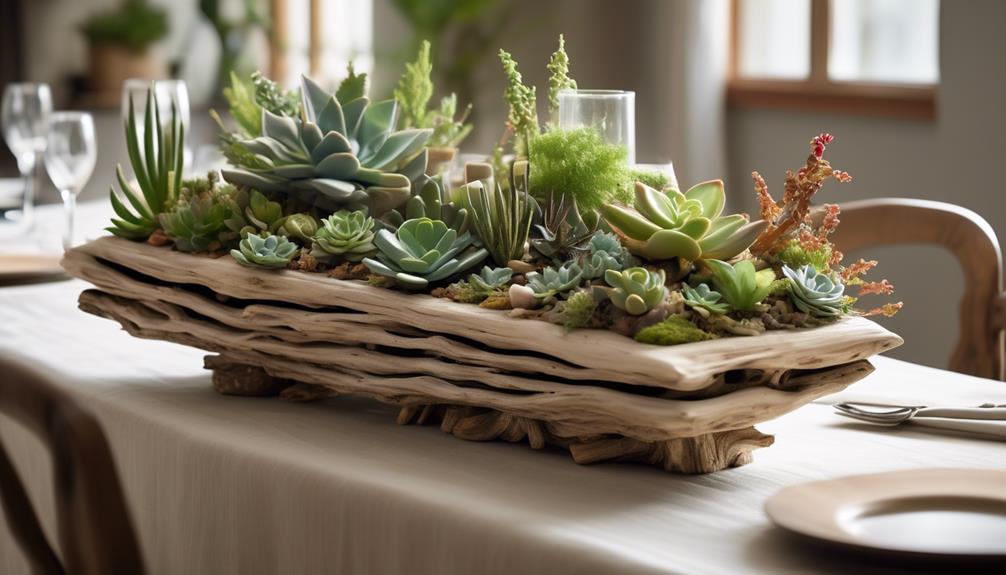
Let's consider the different points when it comes to table shape and size.
We'll discuss the pros and cons of round versus rectangular tables, as well as the importance of height and proportions.
These factors play a crucial role in determining the most suitable centerpiece for various table shapes and sizes.
Round Vs. Rectangular Tables
We find that round tables are more conducive to fostering conversation and promoting a sense of inclusivity among guests, whereas rectangular tables offer a more formal and structured setting for events.
When considering the table shape and size for your centerpiece, keep in mind the following:
- Interaction: Round tables encourage guest interaction due to their inclusive shape.
- Space optimization: Rectangular tables are great for optimizing space and creating a more structured layout for larger events.
- Visual impact: Consider how the table shape will complement the floral arrangements and overall table arrangement.
Understanding the dynamics of round versus rectangular tables is crucial in creating the right ambiance for your event, whether it's fostering intimacy or maintaining a formal setting.
Height and Proportions
When selecting the height and proportions of your table centerpiece, it's essential to consider how they'll complement the overall aesthetic and function of the space. Visual balance is crucial for creating an inviting atmosphere.
Decorative accessories such as candle holders or vases can add dimension to the centerpiece, enhancing its visual appeal. Centerpiece heights should be chosen based on the size and shape of the table.
For larger tables, taller centerpieces can create a striking focal point, while smaller tables may benefit from lower arrangements to facilitate conversation. It's important to ensure that the centerpiece doesn't obstruct the view or hinder interaction among guests.
Height and Visual Impact
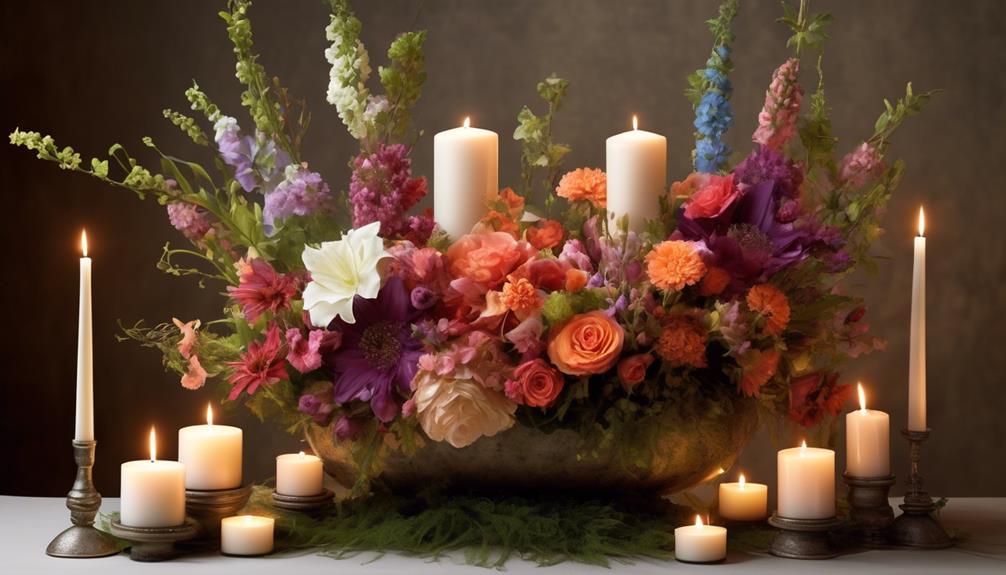
The centerpiece's height and visual impact set the tone for the entire table arrangement, capturing attention and creating a focal point for the space. When it comes to creating a captivating centerpiece, there are a few key considerations to keep in mind:
- Floral arrangements: Incorporating tall, elegant floral arrangements can instantly elevate the visual impact of the centerpiece, adding a touch of natural beauty and sophistication to the table decor.
- Table decor: Mixing and matching varying heights of decorative elements, such as candles, vases, or figurines, can add dimension and visual interest to the centerpiece, drawing the eye and creating a dynamic focal point for the table.
- Lighting: Utilizing strategic lighting, such as dimmed overhead lights or the warm glow of candles, can enhance the visual impact of the centerpiece, casting a soft, inviting ambiance over the table and creating an intimate atmosphere for guests to enjoy.
Practicality and Functionality
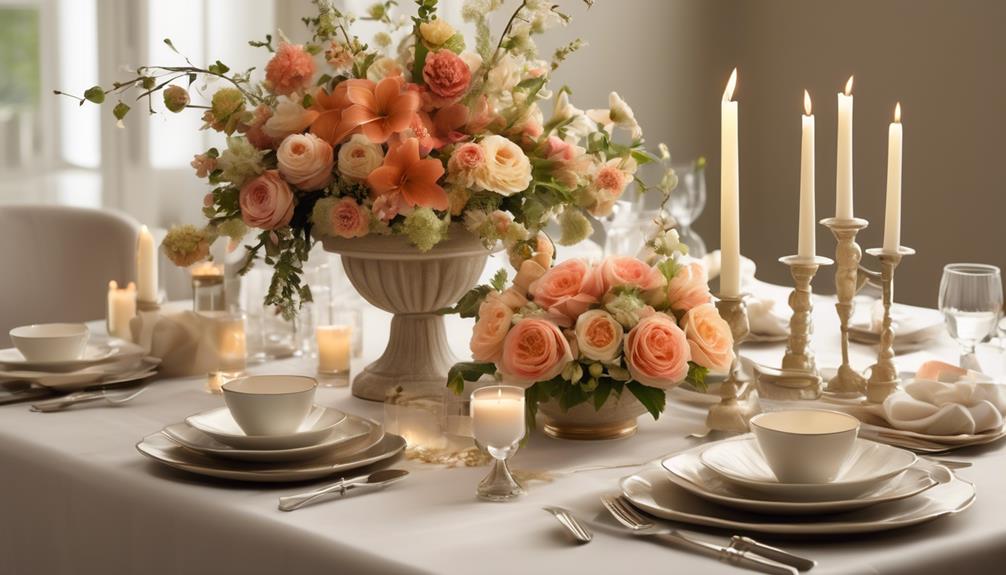
Considering the practicality and functionality of a table centerpiece is essential for ensuring it complements the dining experience without hindering it. When choosing a centerpiece, it's crucial to prioritize efficiency and usability while also focusing on space optimization. The centerpiece should enhance the overall aesthetic of the table without obstructing the view or limiting the space for tableware and food. To emphasize the importance of practicality and functionality, let's consider the following aspects:
| Aspect | Description |
|---|---|
| Size | Choose a size that doesn't overwhelm the table and allows for easy interaction among guests. |
| Height | Opt for a height that doesn't obstruct the view across the table, promoting seamless conversation. |
| Usability | Ensure the centerpiece doesn't hinder the serving or passing of dishes, maximizing convenience. |
| Material | Select materials that are easy to clean and maintain, contributing to a hassle-free dining experience. |
| Flexibility | Consider a design that allows for easy removal during mealtime, promoting practicality and functionality. |
Theme and Cohesion
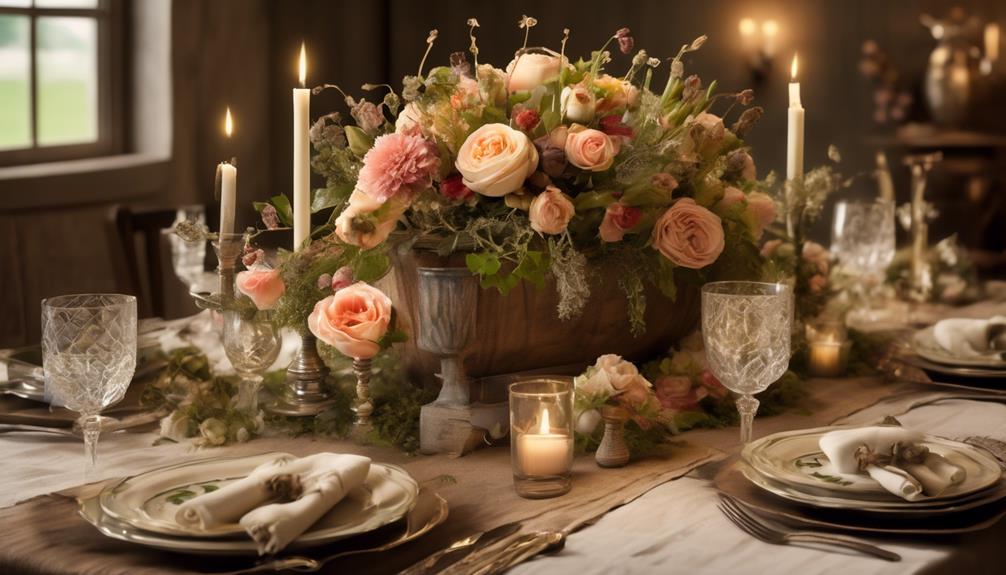
For an aesthetically pleasing table centerpiece, we aim to create a cohesive theme that enhances the overall dining experience. When it comes to theme and cohesion, there are key elements to consider:
- Coordinating Elements: To achieve a cohesive design, it's essential to ensure that all elements of the centerpiece work together harmoniously. This includes considering the colors, textures, and sizes of the various components to create a unified look that complements the dining table.
- Cohesive Design: A well-thought-out theme ties the centerpiece together, whether it's a seasonal motif, a specific color scheme, or a cultural inspiration. This cohesive design brings a sense of purpose and intentionality to the centerpiece, elevating the overall ambiance of the dining space.
- Personal Touch: Infusing the centerpiece with personal touches that reflect the host's or the occasion's personality can further enhance the theme and cohesion. Whether it's incorporating meaningful objects, family heirlooms, or handmade elements, these unique additions can add depth and character to the centerpiece, creating a more intimate and inviting atmosphere.
Frequently Asked Questions
Can I Use Artificial Flowers or Greenery in My Table Centerpiece?
Sure, we love using artificial flowers or greenery in our table centerpiece! They offer the flexibility to maintain a stunning look regardless of the season.
We enjoy incorporating seasonal themes with them, creating beautiful arrangements that last. Artificial options also provide durability and can be reused, making them a practical choice.
Whether it's a cozy dinner or a festive celebration, artificial blooms bring charm and elegance to our table settings.
Are There Any Rules for Incorporating Candles Into a Table Centerpiece?
When it comes to incorporating candles into a table centerpiece, we always consider candle placement and safety considerations first. We make sure that the candle size complements the aesthetic appeal without overwhelming the arrangement.
How Do I Choose a Centerpiece That Won't Obstruct Conversation Across the Table?
When choosing appropriate centerpieces, we aim to maintain table aesthetics without hindering conversation. Opt for low-profile arrangements, like fresh flowers or simple candles, to avoid obstructing sightlines.
Consider using smaller, scattered elements rather than one large piece to promote intimacy and conversation flow. Embrace minimalist, elegant designs that enhance the table's ambiance without overwhelming it.
Ultimately, the goal is to create a welcoming, intimate space that encourages seamless interaction.
What Are Some Non-Traditional Materials I Can Use for a Table Centerpiece?
When it comes to table centerpieces, we love thinking outside the box. Upcycled materials like reclaimed wood or vintage glass can add a unique touch.
Unconventional shapes, such as geometric or asymmetrical designs, can bring a modern twist.
For those seeking sustainable options, minimalist designs with potted plants or succulents can create a serene atmosphere.
These choices not only spark conversation but also reflect our commitment to sustainability and creativity.
Are There Any Guidelines for Incorporating Personal or Sentimental Items Into a Table Centerpiece?
When it comes to incorporating personal mementos and family heirlooms into a table centerpiece, it's all about infusing your unique story and creating a warm, intimate atmosphere.
We believe that there aren't strict guidelines here; it's more about capturing the essence of your family's history and cherishing meaningful items.
Whether it's a vintage photo, a cherished heirloom, or a trinket that holds sentimental value, these personal touches can truly elevate the centerpiece's charm.
Conclusion
So there you have it, the rules for a table centerpiece. Remember, the key to a successful centerpiece is to follow all of these rules diligently and never stray from them.
Because who needs creativity and personal expression anyway? Just stick to the rules and your table will be the epitome of blandness.
Happy centerpiecing!
- About the Author
- Latest Posts
Introducing Ron, the home decor aficionado at ByRetreat, whose passion for creating beautiful and inviting spaces is at the heart of his work. With his deep knowledge of home decor and his innate sense of style, Ron brings a wealth of expertise and a keen eye for detail to the ByRetreat team.
Ron’s love for home decor goes beyond aesthetics; he understands that our surroundings play a significant role in our overall well-being and productivity. With this in mind, Ron is dedicated to transforming remote workspaces into havens of comfort, functionality, and beauty.
Mardi Gras Decoration
What Do the Colors of Mardi Gras Mean Catholic?
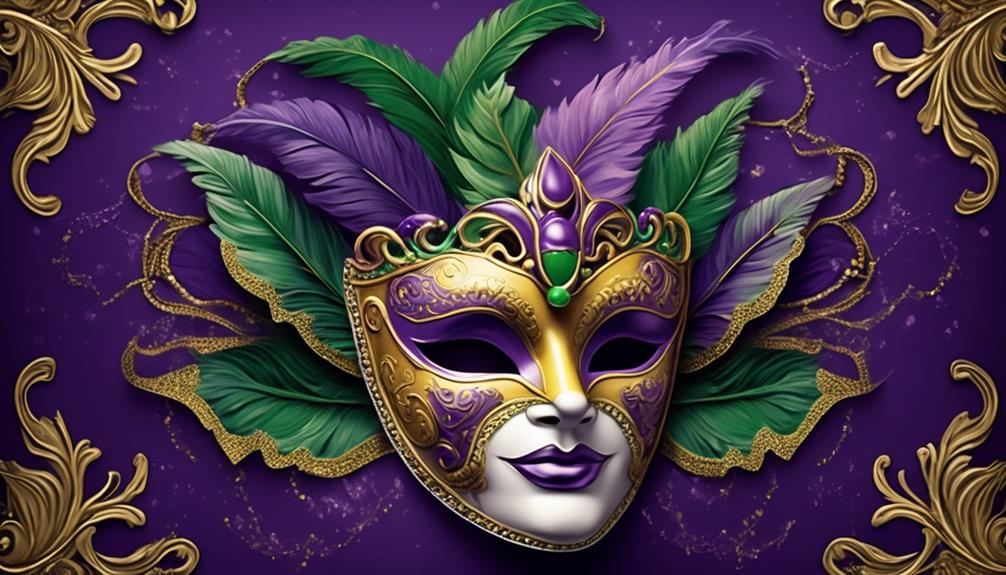
While strolling through the lively streets of New Orleans during Mardi Gras, we couldn’t help but admire the vibrant colors that adorned the floats, costumes, and decorations. The rich purples, greens, and golds appeared to carry a deeper meaning beyond just their visual appeal.
It made us wonder about the origins and meanings behind these traditional Mardi Gras colors, particularly in the context of Catholicism.
What we discovered not only shed light on the historical roots of these hues but also revealed a fascinating layer of symbolism that continues to resonate in modern-day celebrations.
Key Takeaways
- The colors of Mardi Gras (purple, gold, and green) originated in the 12th century and were adopted by the Catholic Church.
- Purple symbolizes justice and the kingship of Christ, gold signifies power and the richness of faith, and green represents faith and renewal.
- The Mardi Gras colors reflect a historical tapestry intertwined with religious symbolism and cultural traditions, embodying tradition, spirituality, and unity.
- The colors have religious significance, with gold symbolizing divine purity, purple representing justice and penance during Lent, and green symbolizing faith and the promise of eternal life.
Origins of Mardi Gras Colors
Exploring the origins of Mardi Gras colors reveals a rich historical tapestry intertwined with religious symbolism and cultural traditions. The evolution of these vibrant hues carries a spiritual significance deeply rooted in Catholicism. The traditional trio of purple, gold, and green holds a profound meaning, reflecting the spiritual and cultural impact of Mardi Gras.
The origins of these colors can be traced back to the 12th century, where they were adopted by the Catholic Church to represent the three key aspects of the Lenten season. Purple symbolizes justice, gold signifies power, and green represents faith. These colors were later incorporated into the Mardi Gras celebration, becoming an integral part of the festival's visual identity.
Over time, the spiritual essence of these colors has intertwined with cultural traditions, shaping the vibrant spectacle that Mardi Gras is today. The evolution of these colors reflects the rich tapestry of history, faith, and community that defines the essence of Mardi Gras, making them much more than just a visual spectacle. They stand as a powerful symbol of tradition, spirituality, and unity.
Symbolism of Purple

Purple holds a significant role in the symbolism of Mardi Gras, representing justice within the Catholic tradition. The color purple has deep symbolic representation rooted in religious traditions and spiritual significance. In the context of Mardi Gras, it's a powerful reminder of the color rituals observed in Catholic liturgical practices.
- Symbolic Representation of Royalty:
Purple has long been associated with royalty and nobility, signifying dignity and authority. In the Catholic faith, it symbolizes the kingship of Christ and the sovereignty of God.
- Religious Traditions and Spiritual Significance:
Within Catholicism, purple is traditionally linked to penance, humility, and preparation. It's used during the Lenten season and Advent as a symbol of repentance, reflection, and spiritual cleansing.
The rich history and symbolism of purple in Mardi Gras celebrations go beyond mere aesthetics, embodying profound spiritual and religious meanings. It serves as a poignant reminder of the values and principles upheld within the Catholic faith, resonating deeply with the essence of justice and spiritual reflection.
Significance of Green
Green holds a significant role in the symbolism of Mardi Gras, representing faith within the Catholic tradition. The color green has deep spiritual and cultural significance, reflecting concepts of growth, renewal, and hope.
In the context of Mardi Gras, green symbolizes the faith aspect of the celebration, signifying the spiritual foundation and beliefs of the Catholic community. The significance of green extends beyond religious connotations, encompassing the natural world and the vibrancy of life. Within the spectrum of Mardi Gras colors, green is a powerful reminder of the spiritual journey and the connection to the earth.
The cultural significance of green has evolved over time, intertwining with various traditions and belief systems. In the context of Mardi Gras, green spirituality emphasizes harmony with nature and the divine, fostering a sense of balance and renewal. The color green also represents the lush foliage of Louisiana, where Mardi Gras holds deep roots.
As we immerse ourselves in the festivities, the color green serves as a poignant reminder of our spiritual interconnectedness and the enduring vitality of faith.
Meaning of Gold

Let's talk about the meaning of gold in the context of Mardi Gras.
Gold holds significant symbolism as it represents wealth, power, and royalty.
In the religious context, gold has a deep spiritual significance that we'll explore in the following points.
Symbolism of Wealth
Gold holds a significant symbolic meaning in the context of Mardi Gras, representing wealth and prosperity in the Catholic tradition. When it comes to color psychology and symbolism, gold is often associated with luxury, success, and achievement.
In the context of cultural traditions and celebrations, the use of gold during Mardi Gras reflects the opulence and grandeur of the event, symbolizing the richness of faith and the abundance of blessings. In Catholic rituals, gold is used to adorn religious artifacts, symbolizing the divine and the sacred.
In the context of the Mardi Gras celebration, gold serves as a reminder of the spiritual wealth and blessings bestowed upon the community. The vibrant and radiant hue of gold also signifies the joy and exuberance of the festivities, adding a touch of splendor to the revelry.
Representing Power and Royalty
Symbolizing authority and nobility, the color gold holds a prominent significance in the traditions and festivities of Mardi Gras. It represents power and royalty, adding an air of majesty and grandeur to the celebrations.
The golden hue, with its warm and radiant tone, embodies the regal essence of Mardi Gras, symbolizing the richness and opulence associated with this vibrant event. In the context of Mardi Gras, gold signifies the enduring tradition of kingship and the splendor of the royal court.
It encapsulates the spirit of leadership and magnificence, elevating the festivities to a realm of grandeur and prestige. As we adorn ourselves in gold during Mardi Gras, we embody the timeless symbolism of royalty, embracing the power representation that has been integral to this cherished tradition for generations.
Significance in Religious Context
In the religious context, the color gold holds profound significance, symbolizing divine purity and enlightenment.
- Gold represents spiritual symbolism, embodying the divine presence and the glory of God.
- It's often used in religious rituals to adorn sacred objects and vestments, signifying the importance of the ceremony and the divine nature of the ritual.
Gold holds a special place in religious traditions, signifying the highest spiritual truths and the radiance of the divine. Its presence in religious rituals and sacred spaces serves as a reminder of the purity and enlightenment sought in spiritual practice.
The use of gold in religious contexts emphasizes the transcendent nature of the divine and the aspiration for spiritual enlightenment within the faith community.
Historical Context of Color Use

How did the historical context influence the choice of colors for Mardi Gras celebrations?
The colors of Mardi Gras hold a deep-rooted significance, shaped by historical traditions and symbolic representation. In the 1870s, the Rex organization designated the official colors of Mardi Gras as purple, green, and gold.
These colors weren't chosen arbitrarily; rather, they were selected based on their cultural significance and color psychology. Purple, representing justice, has long been associated with royalty and was historically worn by rulers and leaders.
Green, symbolizing faith, reflects the lush greenery of spring and the renewal it brings. Lastly, gold, signifying power, exemplifies the richness of the season and the festival's grandeur.
The historical context of these colors reflects the values and ideals of the Mardi Gras celebration, creating a visual representation of its cultural heritage and traditions.
As we revel in the vibrant festivities of Mardi Gras, we're reminded of the enduring historical significance that these colors hold, enriching the experience with depth and meaning.
Association With Catholicism
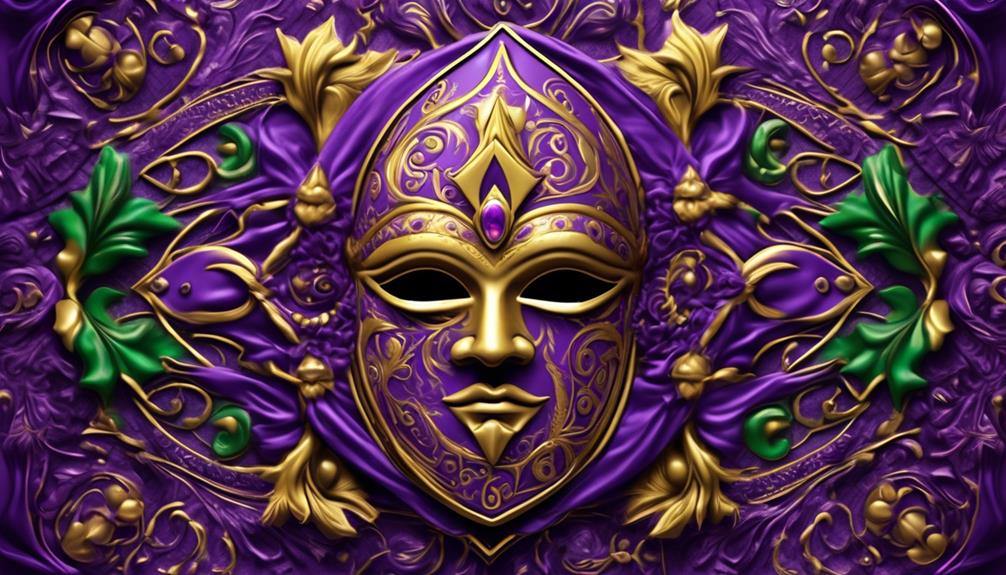
The historical significance of the colors of Mardi Gras, shaped by traditions and symbolism, culminates in their association with Catholicism, adding a layer of religious depth to the festival. The colors of Mardi Gras carry profound significance within Catholicism, reflecting the rich tapestry of religious traditions and cultural symbolism.
- Color Psychology and Religious Traditions
- The color purple, representing justice and penance, reflects the Lenten season and the somber preparation for Easter within Catholic tradition. It serves as a reminder of the importance of reflection and repentance.
- The color green, symbolizing faith, speaks to the hope and renewal that comes with the resurrection of Jesus. It represents the Christian beliefs and the promise of eternal life.
- Catholic Symbolism and Cultural Significance
- The colors of Mardi Gras are deeply intertwined with Catholic symbolism, resonating with the religious community and infusing the festival with spiritual significance.
- Beyond their religious connotations, these colors have become emblematic of the cultural significance of Mardi Gras, uniting revelers in celebration and reflection during the vibrant festivities.
Spiritual Connections to Colors
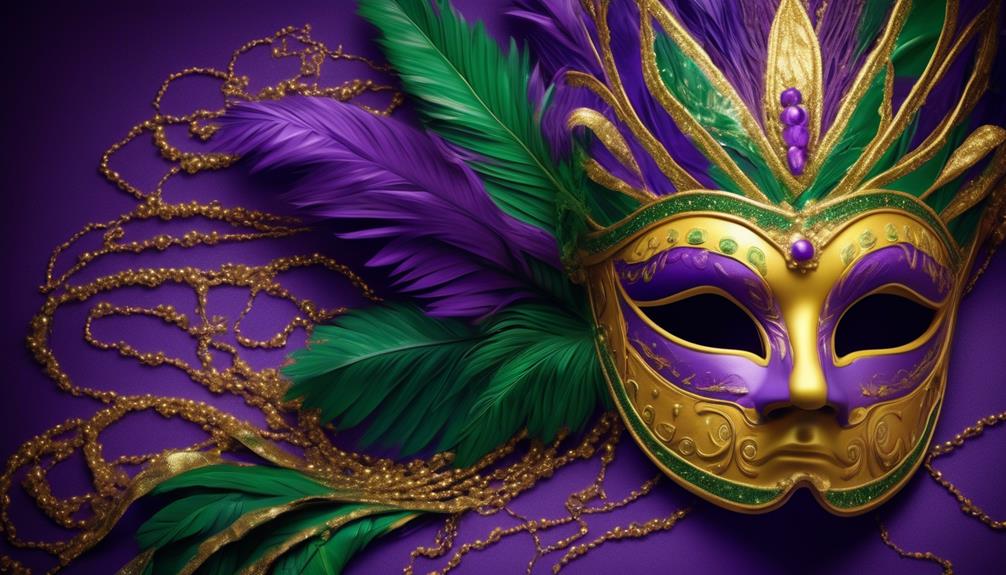
As we explore the spiritual connections to colors, it's fascinating to uncover the symbolism behind each hue.
The religious significance of colors holds deep meaning in various traditions and ceremonies, shedding light on their profound impact.
From color rituals to the significance of specific shades, the spiritual connections to colors offer a rich tapestry of traditions and beliefs.
Symbolism of Colors
Incorporating the symbolic significance of colors in religious and spiritual practices adds depth and meaning to the rituals and traditions of Mardi Gras. The symbolic representation of colors holds great importance in cultural traditions and spiritual beliefs. When it comes to Mardi Gras, the colors of purple, green, and gold are steeped in spiritual connections and symbolic meanings, enriching the celebration with deeper significance.
Purple:
- Represents justice, penance, and royalty in Christianity.
- Symbolizes the passion and suffering of Jesus Christ during Lent.
Green:
- Symbolizes faith, hope, and eternal life.
- Represents the growth and rebirth associated with spring and the resurrection in Christianity.
These symbolic connections to colors infuse Mardi Gras with a spiritual depth that resonates with its participants, adding a layer of significance to the festivities.
Religious Significance
During Mardi Gras, we embrace the spiritual connections of colors, allowing them to enrich our celebration with deeper significance.
The religious symbolism associated with the colors of Mardi Gras holds profound meaning. The purple color represents justice, reminding us of the suffering and sacrifice of Christ. It encourages us to seek righteousness and fairness in our lives.
Gold signifies power and glory, symbolizing the divine presence and the eternal light of God. It urges us to seek spiritual wealth and enlightenment.
Green, representing faith, prompts us to nurture our spiritual growth and strengthen our belief in God.
Understanding the color psychology behind these hues enhances our connection to the religious significance of Mardi Gras, reminding us of our spiritual journey and the values we hold dear.
Color Rituals
The religious symbolism associated with the colors of Mardi Gras extends into color rituals, weaving spiritual connections and deeper significance into our celebration.
Through color psychology, we tap into the subconscious meanings of purple, green, and gold, enriching our experience with their emotional and spiritual resonance.
These color rituals are deeply ingrained in cultural traditions, embodying the essence of our collective heritage and shared values.
As we adorn ourselves with these vibrant hues, we honor our past and present, connecting with the spiritual energy that has transcended generations.
The act of embracing these colors becomes a sacred ritual, a tangible manifestation of our devotion to the traditions and beliefs that bind us together.
In this way, our celebration becomes a living, breathing tapestry of spiritual significance, woven with the threads of color and culture.
Use of Colors in Religious Practices
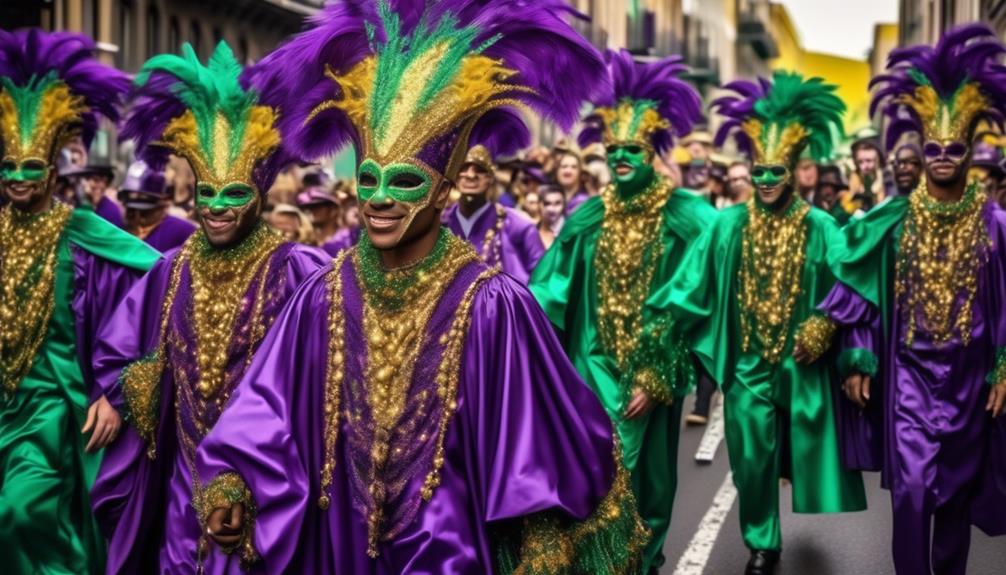
Throughout various religious traditions, colors play a significant role in symbolizing sacred meanings and conveying spiritual messages. In religious symbolism, each color carries specific significance, often rooted in historical, cultural, and spiritual contexts. Color psychology also influences the use of colors in religious practices, as different hues evoke distinct emotions and connections to the divine.
| Color | Symbolism | Usage in Religious Practices |
|---|---|---|
| White | Purity, innocence, light | Worn by clergy, used in baptismal rites |
| Red | Passion, sacrifice, love | Symbolizes the blood of Christ, used in Pentecost celebrations |
| Blue | Tranquility, devotion, heaven | Associated with the Virgin Mary, used in Advent and Marian feasts |
The use of colors in religious practices creates a visual language that communicates deep spiritual truths and resonates with worshippers on an emotional level. Whether adorning sacred vestments, decorating religious spaces, or incorporating colors into religious rituals, the symbolic use of colors fosters a sense of connection to the divine and enhances the spiritual experience for believers.
Evolution of Color Symbolism
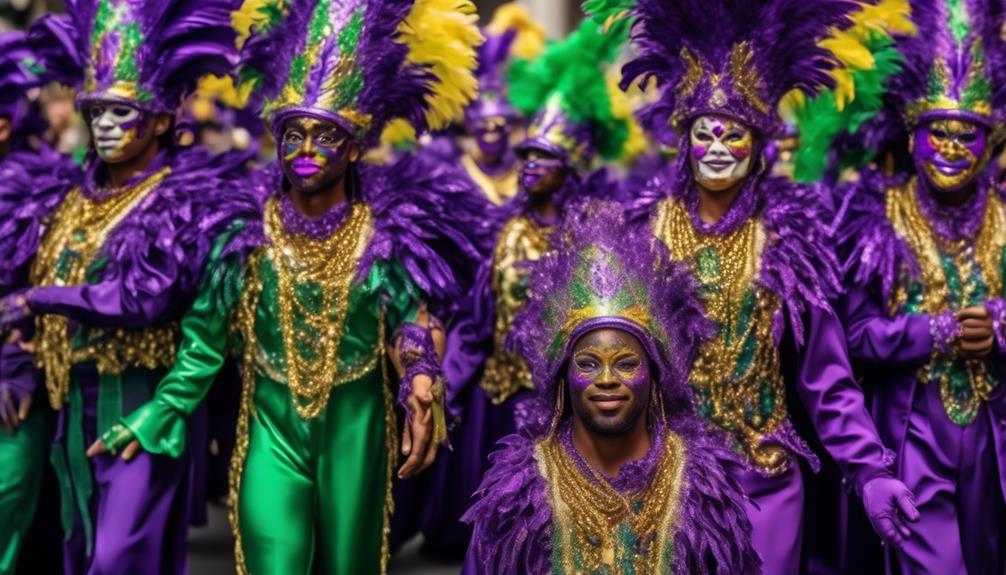
Let's explore how the meanings of colors have evolved over time, reflecting historical contexts and cultural shifts.
We'll delve into the significance of colors in different periods and how they've shaped modern interpretations.
Understanding the evolution of color symbolism will illuminate the rich tapestry of meanings woven into the vibrant traditions of Mardi Gras.
Historical Color Meanings
As colors have held significant cultural and religious symbolism throughout history, their meanings have evolved and adapted to reflect the changing beliefs and practices of different societies.
- Historical Origins of Color Symbolism
- Ancient Civilizations: Colors were associated with deities, virtues, and natural elements.
- Medieval Europe: Colors held symbolic meanings in heraldry, representing noble families and their attributes.
Throughout history, colors have carried deep significance, shaping cultural and religious practices. In ancient civilizations, colors were intertwined with spirituality and mythology, representing the divine and natural world.
In medieval Europe, color symbolism expanded into heraldry, where each hue denoted specific virtues and characteristics of noble families. This evolution of color symbolism reflects the dynamic interplay between culture, spirituality, and societal norms, showcasing the enduring influence of colors on human experience.
Influence of Cultural Shifts
The evolution of color symbolism reflects the dynamic interplay between cultural shifts, spirituality, and societal norms, continually shaping the meanings and associations of different hues.
Cultural shifts play a significant role in altering the significance of colors within religious traditions. As society changes, so do the connotations of various hues. The evolving cultural landscape brings forth new perspectives and interpretations, influencing the symbolism of colors in religious festivities such as Mardi Gras.
These shifts can lead to the redefining of traditional color associations and the emergence of new symbolic meanings. In this way, the impact of cultural changes on color symbolism highlights the interconnectedness between societal transformations and the evolving interpretations of religious traditions.
Such changes in perception can enrich the significance of colors, adding depth and diversity to their symbolic representations in religious and cultural contexts.
Modern Interpretations of Colors
Amidst contemporary societal shifts, our modern interpretations of color symbolism in religious and cultural contexts continue to evolve, reflecting the dynamic interplay between spirituality and changing cultural norms.
- Color psychology
The study of how colors affect human behavior and emotions has led to new insights into the psychological impact of religious and cultural color symbolism.
- Cultural significance
As societal values and norms change, the significance of colors in religious and cultural contexts also undergoes reinterpretation, reflecting the evolving cultural landscape.
Modern interpretations of color symbolism are deeply intertwined with artistic expressions, as artists and creators infuse new meanings into traditional color palettes. This evolution allows for a more nuanced understanding of the role of colors in shaping religious and cultural experiences, resonating with the complexities of modern society.
Cultural Impact of Mardi Gras Colors
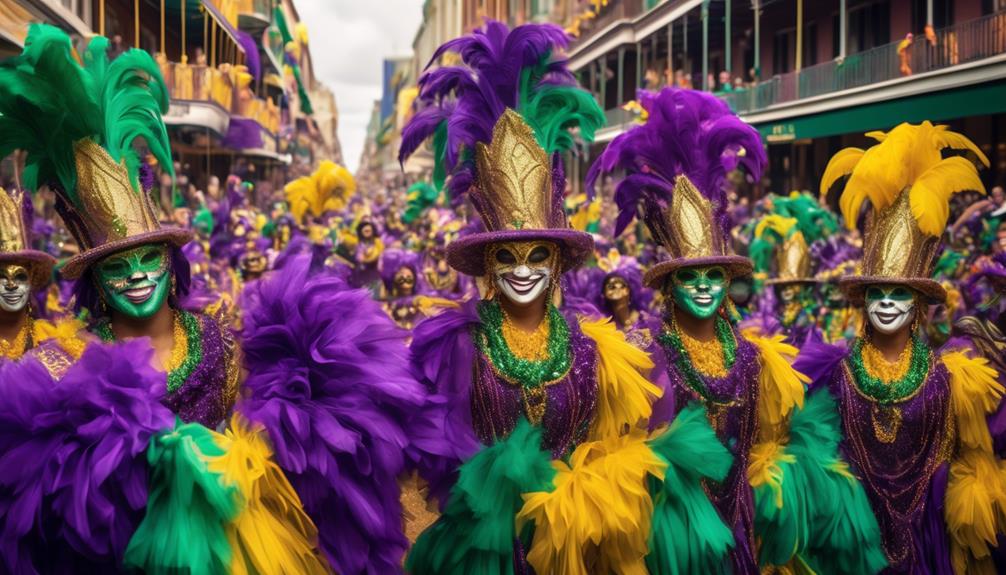
Mardi Gras colors hold significant cultural meaning, symbolizing the rich traditions and spiritual roots of the celebration. The cultural traditions surrounding the colors of Mardi Gras reflect a deep connection to the history and heritage of the event.
The purple color, representing justice, reminds us of the cultural values of fairness and righteousness that have been integral to the Mardi Gras festivities for generations. Gold, symbolizing power, speaks to the cultural significance of strength and resilience within the community. Green, the color of faith, reflects the deep spiritual roots and the enduring faith of the people who celebrate Mardi Gras.
These colors, steeped in cultural traditions and color psychology, have a profound impact on the Mardi Gras celebration, embodying the spirit and ethos of the event.
The cultural impact of Mardi Gras colors extends beyond symbolism, influencing the atmosphere and energy of the celebration. The vibrant and lively combination of purple, gold, and green creates an ambiance of joy, unity, and cultural pride. It fosters a sense of belonging and togetherness, inviting people to embrace the rich cultural tapestry woven into the Mardi Gras tradition.
The colors serve as a visual manifestation of the cultural heritage, evoking a deep emotional connection and a shared sense of identity among participants. The cultural impact of Mardi Gras colors is a testament to the enduring significance of tradition and the power of symbolism in shaping collective experiences.
Contemporary Interpretation of Colors

In today's cultural landscape, we perceive the Mardi Gras colors through a lens that reflects our contemporary values and interpretations. The traditional symbolism of purple for justice, green for faith, and gold for power has evolved to encompass new meanings based on contemporary symbolism and color psychology.
- Contemporary Symbolism
- *Inclusivity*: The Mardi Gras colors now represent inclusivity and diversity, reflecting the modern societal emphasis on acceptance and unity.
- *Celebration of Individuality*: Each color is seen as a celebration of individuality, with purple symbolizing uniqueness, green representing growth, and gold signifying prosperity and success.
In our current understanding, the Mardi Gras colors have become a reflection of our collective values and aspirations. Purple, green, and gold now embody a deeper significance, resonating with our contemporary beliefs and desires. As we navigate the complexities of modern life, these colors serve as a reminder of the importance of justice, faith, and power, not just in the traditional sense, but also in the context of our evolving societal ethos.
Frequently Asked Questions
How Do the Mardi Gras Colors Relate to the Traditional Catholic Liturgical Calendar?
The Mardi Gras colors hold a traditional symbolism that relates to the liturgical calendar of the Catholic Church. Their significance is deeply rooted in the religious traditions of the faith.
The colors, purple, gold, and green, are tied to the liturgical calendar, each representing different aspects of the faith. Purple symbolizes penance and preparation, gold represents power and glory, and green signifies hope and life.
This connection highlights the rich religious significance of the Mardi Gras celebration.
Are There Any Specific Religious Rituals or Ceremonies Associated With the Mardi Gras Colors Within the Catholic Church?
In the Catholic faith, the Mardi Gras colors hold deep religious symbolism. These colors are closely tied to traditional Catholic traditions and the liturgical calendar. They bear significant religious meaning, representing various aspects of faith and the journey through the church calendar.
The Mardi Gras customs and rituals associated with these colors reflect the religious significance of colors within Catholicism, adding depth and reverence to the celebration.
How Have the Meanings and Uses of the Mardi Gras Colors Evolved Over Time in Relation to Catholicism?
Over time, the evolution of Mardi Gras colors has held deep symbolism within Catholicism, reflecting cultural significance. The hues, purple, green, and gold, have become intertwined with the religious and festive traditions of this celebration.
Their meanings have evolved to embody themes of penance, faith, and power, resonating with the Catholic community.
The colors now serve as a vibrant expression of the faith and heritage, enriching the festive spirit of Mardi Gras.
Are There Any Specific Saints or Religious Figures Associated With the Mardi Gras Colors in Catholic Tradition?
In Catholic tradition, the Mardi Gras colors hold deep symbolism. They're associated with specific saints and religious figures, reflecting the spiritual significance of the celebration.
The colors, purple, green, and gold, represent various aspects of faith and religious traditions. For instance, purple signifies penance and preparation, while green symbolizes hope and growth. Gold, on the other hand, represents power and glory.
These colors are deeply intertwined with the spiritual fabric of Mardi Gras.
What Are Some Common Ways That Catholic Communities Incorporate the Mardi Gras Colors Into Their Religious Practices and Celebrations?
In our Catholic communities, the Mardi Gras colors hold deep religious symbolism and cultural significance.
We incorporate these vibrant hues into our religious practices and celebrations by using them to represent the values of faith, justice, and power.
Whether through decorating our churches, creating religious art, or adorning our attire, the purple, green, and gold colors serve as a powerful reminder of our faith and the joyous spirit of Mardi Gras.
Conclusion
As we revel in the vibrant hues of Mardi Gras, let's remember the rich history and symbolism behind the traditional colors.
Like a lively parade, the purple, green, and gold dance together in a celebration of faith, justice, and power.
These colors, steeped in tradition and religious significance, continue to paint a colorful tapestry of cultural heritage and community spirit, adding depth and meaning to the festive season.
- About the Author
- Latest Posts
Introducing Ron, the home decor aficionado at ByRetreat, whose passion for creating beautiful and inviting spaces is at the heart of his work. With his deep knowledge of home decor and his innate sense of style, Ron brings a wealth of expertise and a keen eye for detail to the ByRetreat team.
Ron’s love for home decor goes beyond aesthetics; he understands that our surroundings play a significant role in our overall well-being and productivity. With this in mind, Ron is dedicated to transforming remote workspaces into havens of comfort, functionality, and beauty.
Mardi Gras Decoration
How Does the Tradition of the King's Cake Work?
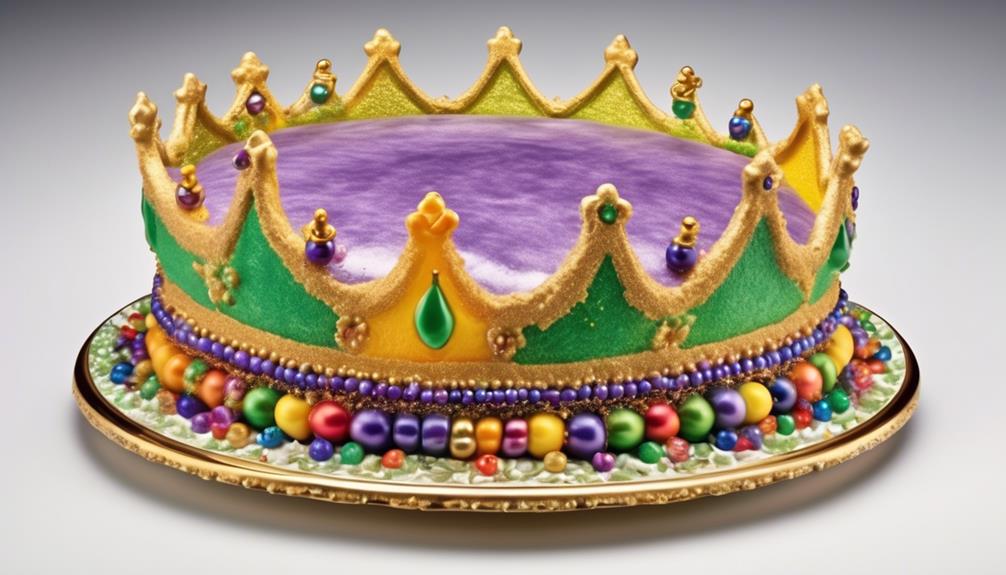
When we delve into the extensive history of the king’s cake, we unveil a beautiful blend of tradition, symbolism, and decadent flavors. This cherished dessert has become intertwined with various cultures, each contributing its own special touch to this long-standing custom.
But how exactly does this cake, crowned with a royal name, work its magic? Let's unravel the layers of this delectable tradition and explore the fascinating customs that have made the king's cake a cherished part of celebrations around the world.
Key Takeaways
- The King's Cake is a tradition that originated in ancient Roman and medieval European cultures and is associated with the Feast of Epiphany.
- The cake symbolizes the pursuit of finding the divine in everyday life and represents the search for spiritual truth and enlightenment within the community.
- The tradition includes a hidden trinket, often representing baby Jesus, which brings luck and prosperity to the person who finds it and makes them the "king" or "queen" of the festivities.
- The King's Cake has evolved over time, with variations in ingredients and flavors, as well as the addition of modern traditions such as online ordering and sharing experiences on social media. It is celebrated globally during the Carnival season and is a central feature of Three Kings' Day and Epiphany celebrations.
Origins of the King's Cake
The origins of the King's Cake can be traced back to ancient Roman and medieval European traditions. With its cultural significance deeply rooted in history, this cake has evolved over time, carrying with it religious symbolism and modern traditions.
In ancient Rome, a cake with a hidden bean or coin was part of the Saturnalia festival, where the person who found the token would be crowned the 'king' of the feast. This tradition continued into medieval Europe, where the cake became associated with the Feast of Epiphany, celebrating the arrival of the Three Kings to visit the infant Jesus.
The cake's round shape and the hidden token symbolized the circular journey of the kings and the search for the Christ child. Today, the King's Cake is enjoyed in various forms across the globe, from the Galette des Rois in France to the Roscón de Reyes in Spain, each with its unique cultural twist.
Its enduring presence in celebrations reflects the enduring nature of traditions and their ability to connect us to our collective past.
Symbolism in the Cake
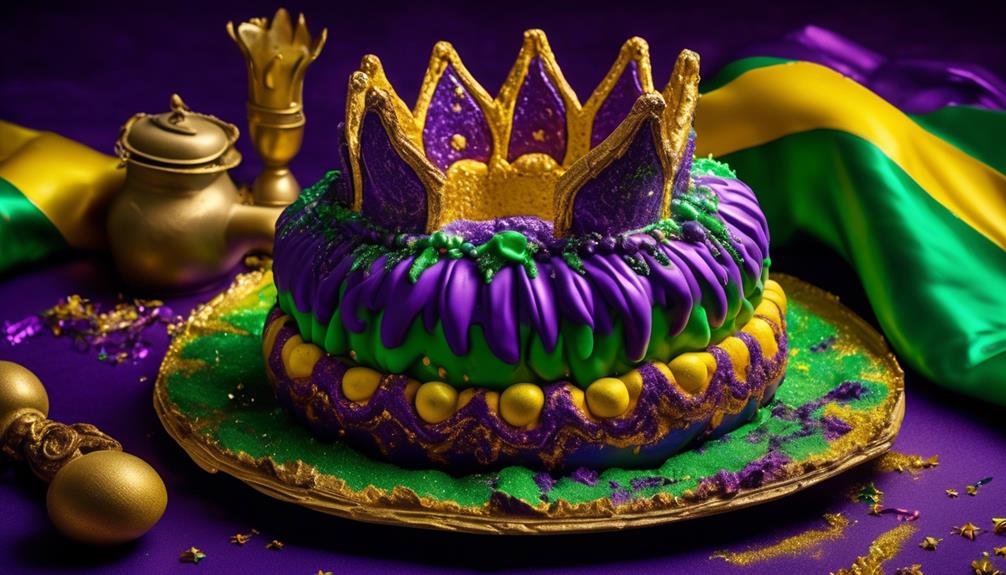
The King's Cake holds deep symbolism, from its religious significance to the tradition of hiding a trinket inside.
As we explore the layers of meaning behind this beloved dessert, we'll uncover the rich traditions and customs associated with the King's Cake.
This symbolic pastry carries with it a sense of community, tradition, and the joy of sharing in festivities.
Religious Symbolism
In the King's Cake, the hidden figurine represents a religious symbol of the pursuit of finding the divine in everyday life. The religious imagery in the King's Cake holds cultural significance, as it symbolizes the search for spiritual truth and enlightenment within the community. This tradition reminds us of the importance of seeking the divine in the ordinary, and the joy that comes with discovering it. The cake serves as a reminder that spirituality is not confined to sacred spaces, but can be found in the simple moments of sharing a meal with loved ones. This symbolism emphasizes the idea that the divine is present in our daily lives, and the King's Cake tradition encourages us to actively seek and celebrate it.
| Religious Symbolism in the King's Cake | |||
|---|---|---|---|
| Represents the pursuit of finding the divine in everyday life | Holds cultural significance | Symbolizes the search for spiritual truth and enlightenment within the community | Reminder of the importance of seeking the divine in the ordinary |
Hidden Trinket Tradition
Embedded within the delectable layers of the King's Cake lies a hidden trinket that adds an element of surprise and tradition to the celebratory dessert.
The tradition of hiding a trinket within the King's Cake has a rich history dating back to ancient Roman times. In those days, a bean or coin was hidden in a cake, and whoever found it was considered blessed for the year.
This practice evolved over time and became associated with the celebration of Epiphany in Christianity. The trinket, often a small figurine or bean, holds cultural significance, symbolizing luck, prosperity, and the discovery of the baby Jesus by the three wise men.
The person who finds the trinket in their slice of cake is traditionally designated as the 'king' or 'queen' of the festivities and may even be tasked with hosting the next gathering.
This delightful custom adds an air of excitement and camaraderie to the joyous occasion.
Traditional Ingredients
Using a secret blend of spices and a rich, buttery dough, traditional King's Cake is meticulously crafted to create a luscious and indulgent treat.
The traditional recipes for King's Cake vary across different cultures, but they commonly include ingredients such as flour, sugar, eggs, butter, milk, and yeast. What sets the King's Cake apart are the special additions like aromatic cinnamon, nutmeg, and sometimes a hint of almond, which infuse the cake with warm, comforting flavors.
The cultural significance of these ingredients is deeply rooted in the history of the cake, with each component symbolizing aspects of the celebration. For example, the richness of the butter and eggs represents the wealth and prosperity associated with the feast, while the spices evoke the exotic flavors of the East, echoing the journey of the Three Kings.
The careful selection and combination of these ingredients not only contribute to the cake's distinctive taste but also honor the traditions and stories that have been passed down through generations. Each bite becomes a delightful homage to the heritage and customs surrounding this beloved confection.
Baking and Decoration

Now, let's talk about the art of baking and decorating the King's Cake.
We'll explore the essential ingredients and tools needed to create this delectable treat, from the rich dough to the vibrant colored sugars and figurines.
Additionally, we'll delve into the traditional designs that adorn the King's Cake, each with its own symbolism and significance.
Cake Ingredients and Tools
In preparing the King's Cake, the baker gathers high-quality ingredients such as flour, sugar, butter, eggs, and yeast, along with essential tools including mixing bowls, measuring cups, a stand mixer, and decorating piping bags.
When it comes to cake decoration, investing in good quality food coloring, edible glitter, and various piping tips can elevate the final presentation.
Baking techniques such as the creaming method for incorporating butter and sugar, and the folding method for gentle mixing of flour into the batter, are crucial for achieving the perfect texture.
Additionally, using parchment paper to line the cake pans and a rotating cake stand for easy frosting application are indispensable.
The right tools and ingredients are the foundation for creating a King's Cake that isn't only delicious but also visually stunning.
Traditional Cake Designs
When designing traditional cakes, bakers incorporate cultural and historical elements to create visually stunning and meaningful confections. Cake decoration reflects a fusion of cultural customs, each design telling a unique story. For instance, intricate henna designs on Indian wedding cakes symbolize joy, beauty, and spiritual awakening. In contrast, the three-tiered fruitcake, adorned with sugared fruit and ribbons, represents prosperity and longevity in British customs. The use of colors, patterns, and symbols in traditional cake designs reflects the values and beliefs of a community. These designs not only celebrate special occasions but also serve as a form of artistic expression, preserving cultural heritage. By incorporating these elements, bakers infuse their creations with a sense of tradition and belonging, making each cake a work of art and a symbol of shared cultural identity.
| Traditional Cake Designs | Cultural Symbolism |
|---|---|
| Henna designs on Indian wedding cakes | Joy, beauty, spiritual awakening |
| Three-tiered fruitcake with sugared fruit | Prosperity, longevity |
| Intricate patterns and symbols | Values and beliefs |
| Use of vibrant colors | Celebration and expression |
| Incorporation of cultural heritage | Tradition and belonging |
Hidden Trinkets and Charms

The tradition of the King's Cake involves hiding trinkets and charms within the sweet pastry, adding an element of excitement and surprise to the celebration. This playful custom has deep cultural roots and makes the King's Cake not just a delicious dessert, but also a source of joy and anticipation.
Here's a closer look at this delightful tradition:
- Festive Surprises: As we slice into the King's Cake, the anticipation of finding a hidden trinket or charm creates a sense of excitement and camaraderie among friends and family.
- Symbolic Meanings: The trinkets and charms tucked inside the cake often carry symbolic meanings. From representing good luck and prosperity to symbolizing the finder as the 'king' or 'queen' of the gathering, these tiny treasures add layers of meaning to the occasion.
- Traditional Superstitions: In some cultures, finding the hidden trinket is believed to bring good fortune or even bestow certain responsibilities upon the discoverer, adding an element of cultural superstition to the fun.
- Memorable Moments: The moment when someone discovers a trinket in their slice of cake becomes a cherished memory, creating a lasting bond and adding an extra dash of delight to the festivities.
Historical Celebrations
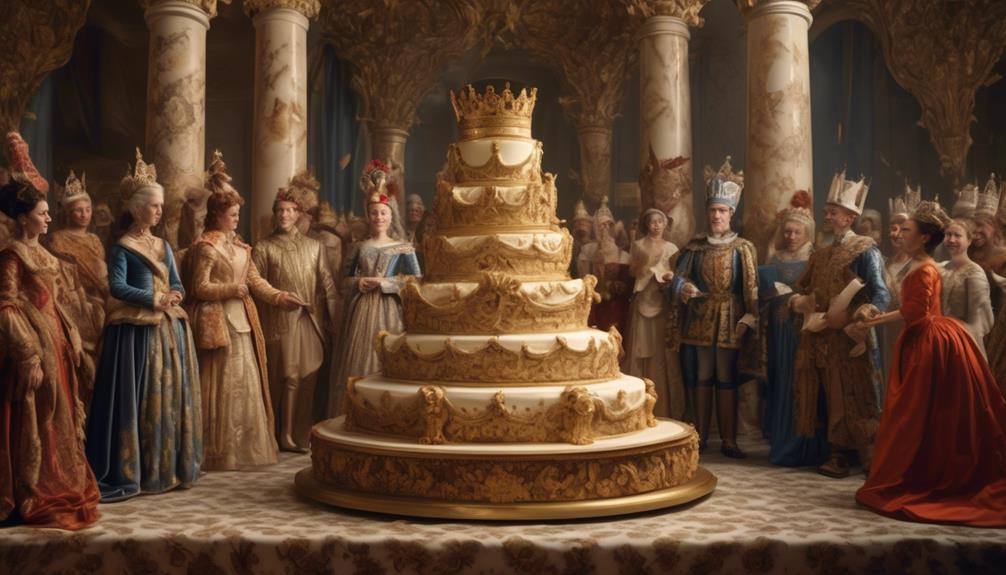
Let's journey back in time to uncover the origins of the King's Cake and its historical significance.
Understanding the cultural celebrations and traditions surrounding this delectable dessert can provide valuable insights into the customs of different societies.
As we explore the historical context, we'll also shed light on how these traditions have evolved and adapted to modern times.
Origins of King's Cake
Amidst the historical celebrations of ancient Rome and medieval Europe, the tradition of the King's Cake first emerged, marking a significant cultural and religious event.
The origins of the King's Cake are rooted in the following:
- Cultural Significance: The King's Cake originated as part of the Roman Saturnalia festival, where a bean was hidden in a cake to determine the 'king of the feast.'
- Religious Symbolism: In medieval Europe, the cake became associated with the Epiphany, representing the arrival of the three wise men and the revelation of Jesus as the son of God.
- Modern Day Customs: Today, the King's Cake is a popular tradition during the Carnival season, with variations in ingredients and decorations across different cultures.
- Global Influence: Over time, the tradition has spread worldwide, adapting to various cultural and religious contexts while maintaining its core symbolism.
Cultural Significance
Emerging from the historical celebrations of ancient Rome and medieval Europe, the cultural significance of the King's Cake is deeply intertwined with the traditions of the Roman Saturnalia festival and the religious symbolism associated with the Epiphany. The cake has become a central element in various cultural traditions, symbolizing the search for the divine and the manifestation of Christ. It is often linked to festive celebrations, where families and friends gather to share this special dessert, reinforcing bonds and creating cherished memories. This communal aspect is reflected in the tradition of hiding a bean or figurine within the cake, adding an element of surprise and excitement to the festivities. The table below illustrates the emotional significance of the King's Cake in these cultural traditions.
| Emotion | Description |
|---|---|
| Togetherness | Gathering of loved ones |
| Excitement | Anticipation of finding the hidden token |
| Tradition | Passing down cultural customs |
Modern Traditions
Modern traditions surrounding the King's Cake have evolved from historical celebrations, adapting to contemporary cultural practices while retaining the cake's symbolic significance. In today's celebratory practices, the King's Cake has taken on new meanings and customs, reflecting cultural variations and modern preferences.
Here are some modern traditions associated with the King's Cake:
- Hidden Trinkets: Instead of the traditional bean or figurine, modern versions of the King's Cake may hide diverse trinkets representing good luck, prosperity, or love.
- Flavor Innovations: Bakers now experiment with various flavors, from classic cinnamon and pecan to innovative combinations like chocolate and raspberry, appealing to different taste preferences.
- Online Ordering: With the convenience of online shopping, people can now easily order King's Cakes from bakeries across the globe, allowing for wider accessibility to this traditional treat.
- Social Media Sharing: Modern celebrants often share their King's Cake experiences on social media, creating a sense of community and shared tradition.
Epiphany and Three Kings' Day
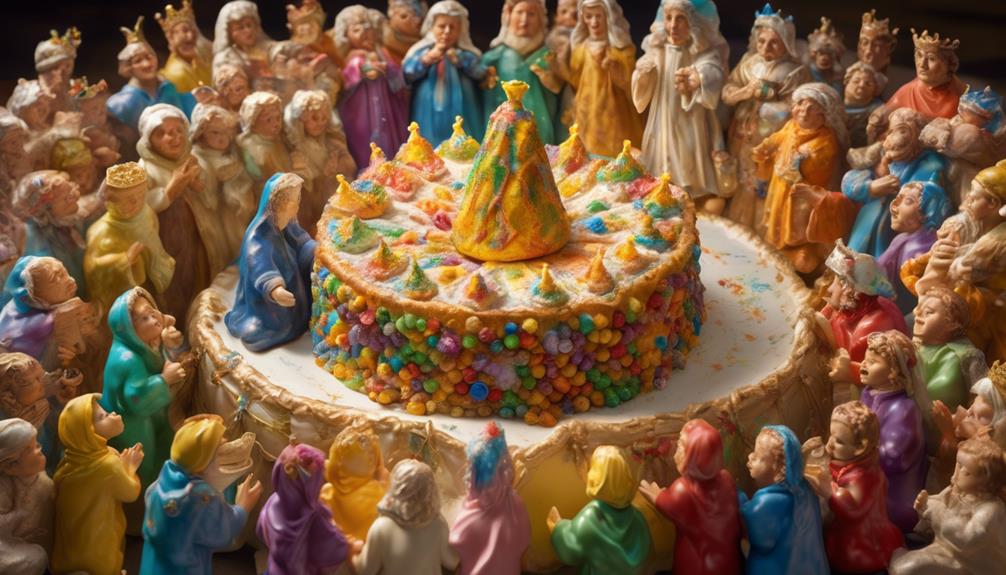
Epiphany and Three Kings' Day mark the culmination of the Christmas season and are celebrated in various cultures around the world. Three Kings' Day, also known as the Feast of the Epiphany, falls on January 6th and commemorates the visit of the Magi to the baby Jesus. In many countries, this day is a public holiday and is celebrated with great fervor. The traditions and customs associated with Epiphany celebrations vary widely, but they often include religious services, parades, and the consumption of special foods like the King's Cake.
In some cultures, it's customary to hold processions reenacting the journey of the Three Wise Men, with participants dressed in elaborate costumes. The day's festivities may also include the blessing of homes and the exchange of gifts. The King's Cake, a sweet pastry often baked in the shape of a crown and adorned with colorful decorations, is a central feature of the celebrations. It's customary to hide a small figurine or trinket within the cake, and whoever finds it's said to have good luck for the coming year. This tradition adds an element of excitement and surprise to the joyous occasion.
Mardi Gras Festivities
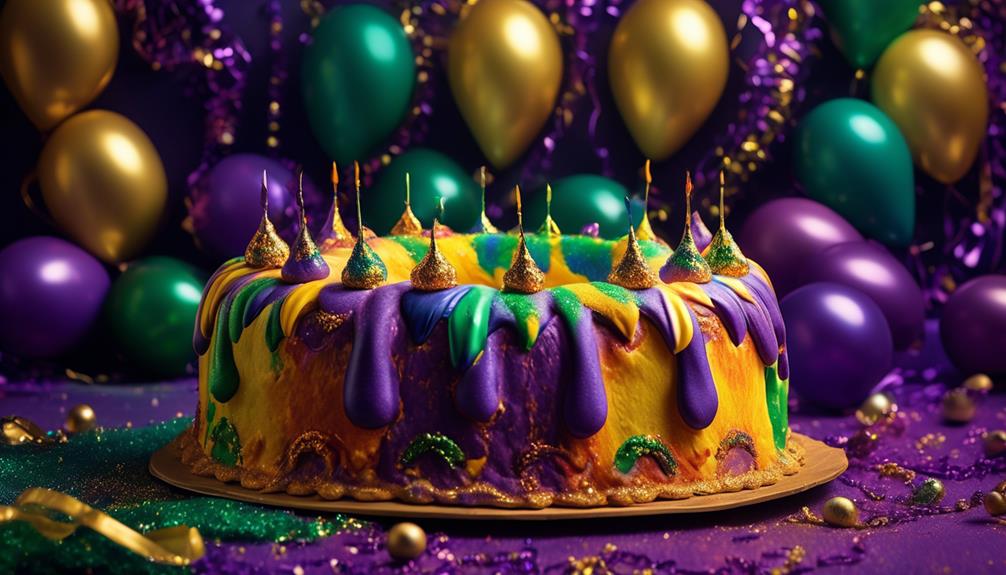
As we shift our focus to Mardi Gras festivities, we can't help but think about the vibrant and lively celebrations that accompany this annual event.
The tradition of the King's Cake takes center stage during these festivities, with its origins deeply rooted in the customs of Epiphany and Three Kings' Day.
One of the most exciting aspects of the King's Cake is the symbolic baby hidden inside, adding an element of surprise and tradition to the Mardi Gras season.
King's Cake Origins
The tradition of the King's Cake, a beloved part of Mardi Gras festivities, has its origins rooted in the rich cultural tapestry of medieval Europe. Our fascination with this delectable treat is deeply intertwined with its historical and cultural significance, as well as the religious symbolism associated with it.
Here's a glimpse into the intriguing origins of the King's Cake:
- Medieval European Roots: The King's Cake originated in medieval France, where it was closely linked to the Feast of Epiphany.
- Religious Significance: The cake symbolizes the biblical story of the three kings visiting the infant Jesus, with the hidden trinket representing the Christ child.
- Cultural Traditions: Over time, the cake became associated with various customs, including the crowning of a king or queen for the day.
- Modern Celebrations: Today, the King's Cake continues to be an integral part of Mardi Gras festivities, with its consumption extending throughout the Carnival season.
Symbolic Baby Inside
Rooted in medieval France, the King's Cake holds a symbolic baby inside, adding an element of surprise and tradition to the vibrant Mardi Gras festivities.
The baby, often made of plastic, represents baby Jesus and symbolizes luck and prosperity. When the cake is sliced and shared among guests, finding the baby in your slice is considered auspicious and brings the responsibility of hosting the next gathering.
This delightful custom has evolved over time, with cultural variations influencing the presentation of the symbolic baby. In some regions, the baby is baked into the cake, while in others, it's placed underneath or inserted after baking.
These cultural differences add to the richness of the tradition and offer a fascinating glimpse into the diverse ways the King's Cake is celebrated across the world.
Mardi Gras Tradition
Mardi Gras festivities burst with vibrant colors, lively music, and exuberant parades, creating a jubilant atmosphere that captivates locals and visitors alike. As we immerse ourselves in the Carnival traditions, a few key elements stand out:
- Floats and Throws: Mardi Gras parades are renowned for their elaborate floats, where krewes throw beads, doubloons, and trinkets to the cheering crowd. It's an exhilarating experience to catch these colorful treasures.
- Masked Revelry: The tradition of wearing masks during Mardi Gras dates back centuries, adding an air of mystery and excitement. Participants often craft intricate and flamboyant masks, contributing to the festival's allure.
- Music and Dance: The rhythmic beats of brass bands and the infectious energy of Mardi Gras music compel everyone to dance along, creating an irresistible urge to join the celebration.
- Indulgent Feasting: The revelry is accompanied by indulgent feasting, with traditional Creole and Cajun cuisines taking center stage, adding a delightful culinary dimension to the festivities.
Global Variations
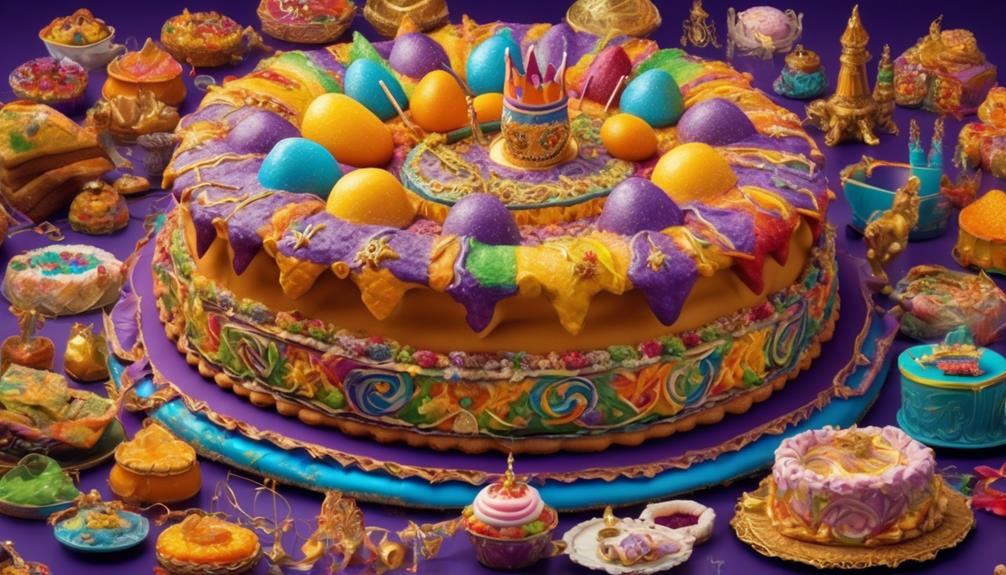
Exploring the global variations of the King's Cake reveals a rich tapestry of cultural influences and unique interpretations.
In France, the Galette des Rois is a puff pastry filled with almond cream, while in Spain and Latin America, the Roscón de Reyes is a sweet, decorated bread-like cake.
Cultural variations are evident in the choice of flavors and fillings, with some regions favoring fruity fillings, while others prefer nut-based or chocolate fillings.
The festive decorations also vary widely, with some cultures favoring colorful sprinkles and icing, and others incorporating symbolic trinkets and figurines within the cake.
In Greece, for example, a coin is often hidden within the cake, and the person who finds it's considered blessed with good luck for the year.
These global variations highlight the significance of the King's Cake as a symbol of unity and celebration across different cultures.
It's fascinating to see how each region has adapted the tradition to reflect its unique customs and culinary preferences, adding depth and richness to the global tapestry of this beloved festive treat.
King Cake Baby Tradition

The tradition of the King Cake Baby adds an element of surprise and fun to the King's Cake festivities, as revelers eagerly anticipate who'll find the hidden baby figurine and be bestowed with good luck and the responsibility of hosting the next celebration.
- Cultural Significance: The King Cake baby holds deep cultural significance, symbolizing luck and prosperity. Finding the baby in your slice not only brings good fortune but also carries the responsibility of hosting the next King's Cake celebration, keeping the tradition alive.
- Symbol of Unity: The King Cake baby is more than just a trinket; it symbolizes unity and community. The person who discovers the baby becomes the focal point of the celebration, fostering a sense of togetherness and camaraderie among participants.
- Secrecy and Excitement: The anticipation of finding the baby creates an air of secrecy and excitement during the cake-cutting ceremony. It adds an extra layer of enjoyment to the event as everyone waits with bated breath to see who'll uncover the hidden treasure.
- Generational Bond: Passing down the tradition of the King Cake baby from one generation to the next strengthens familial and cultural bonds, creating a shared experience that transcends time. It's a way of preserving heritage and celebrating the ties that bind us.
Royal Court and King's Cake
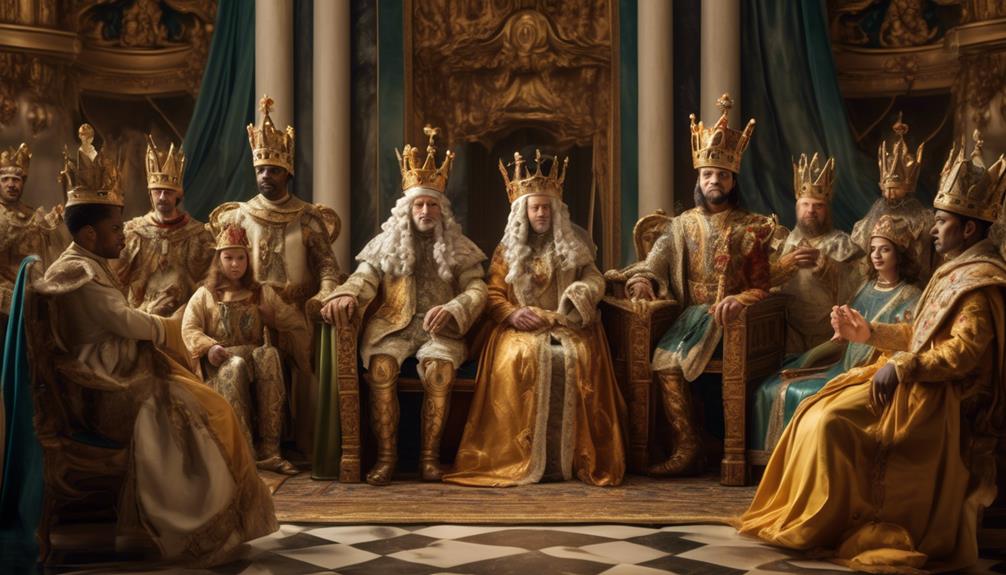
As we delve into the tradition of the Royal Court and its connection to the King's Cake, we uncover the rich history and symbolism woven into this time-honored custom.
Royal court celebrations were often marked with elaborate feasts and the serving of festive desserts, with the King's Cake being a centerpiece of these indulgent gatherings. The cake itself, often rich in flavor and adorned with regal colors, was a symbol of opulence and abundance, fit for honoring the monarch and the esteemed members of the royal court.
During royal court celebrations, the King's Cake took on a special significance. Its circular shape represented the unending cycle of the seasons and the eternal nature of the monarchy, while the hidden trinket or bean within the cake added an element of surprise and anticipation to the festivities. The person who found the trinket was bestowed with the honor of being the 'king' or 'queen' for the day, adding an element of lighthearted fun to the solemnity of the royal court.
The King's Cake thus became a focal point of royal gatherings, symbolizing not only wealth and luxury but also the spirit of camaraderie and revelry within the esteemed circles of the monarchy.
Modern-Day Customs
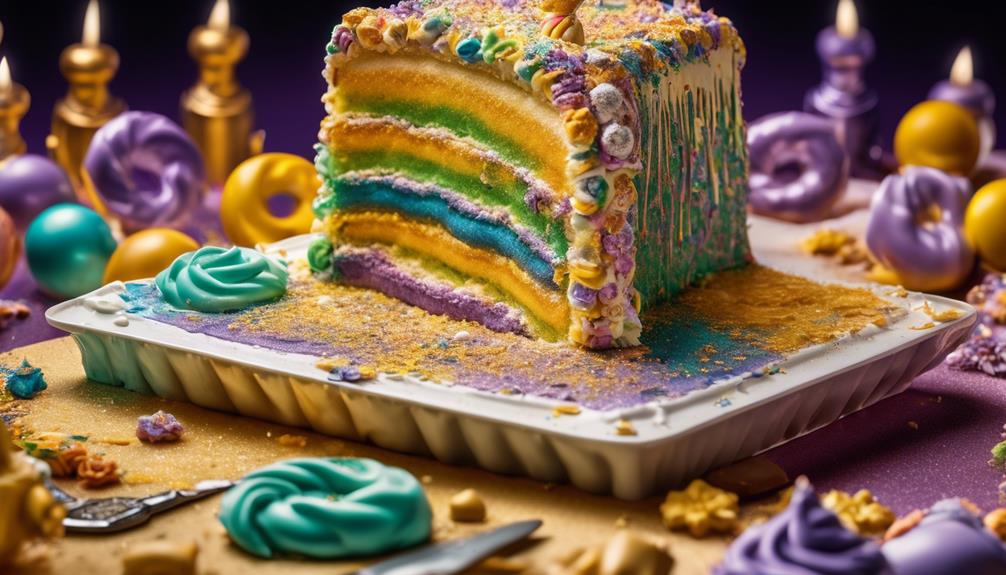
After uncovering the historical significance of the King's Cake in royal court celebrations, we can now explore how modern-day customs have adapted and evolved this tradition into contemporary society. Cultural evolution and changing social dynamics have influenced the way the King's Cake is celebrated today. Here are some contemporary practices:
- Diverse Flavors: Today, King's Cakes come in a variety of flavors such as chocolate, cream cheese, and fruit-filled, catering to modern taste preferences while still preserving the symbolic trinket hidden within.
- Social Gatherings: The tradition of sharing King's Cake has evolved into social gatherings where friends and family come together to enjoy the cake, fostering a sense of community and togetherness.
- Online Ordering: With the advent of technology, people can now order King's Cakes online, making it more accessible to a wider audience, regardless of geographical location.
- Inclusive Trinkets: To reflect contemporary values of inclusivity, some modern King's Cakes feature diverse trinkets that represent various cultural symbols, encouraging unity and diversity within the tradition.
These modern-day customs reflect the adaptability and timelessness of the King's Cake tradition, ensuring its relevance in today's society.
King's Cake in Popular Culture
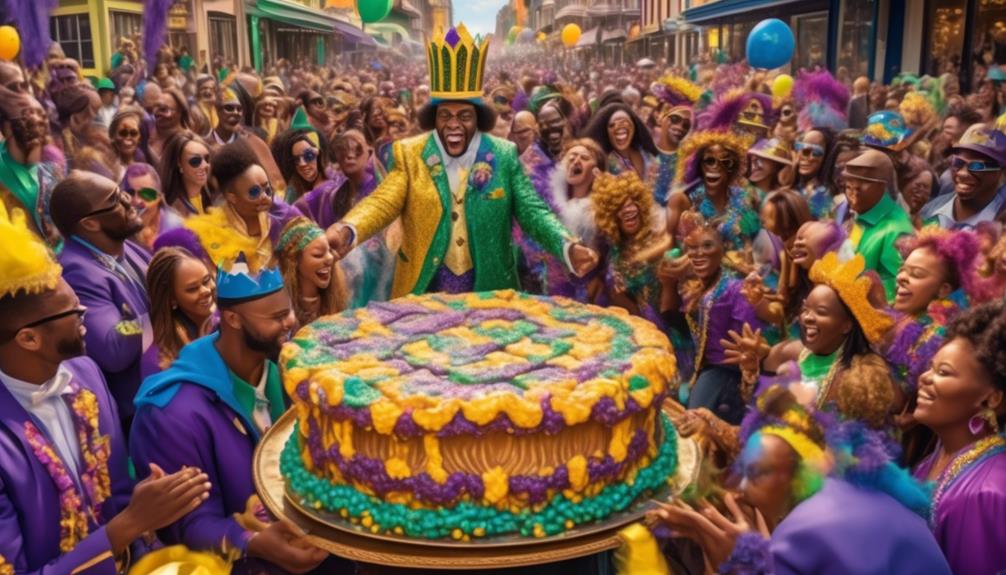
In popular culture, King's Cake has become a symbol of celebration and community, with its presence extending beyond traditional festivities into various forms of media and social gatherings. The rich history of King's Cake has permeated popular culture, appearing in movies, TV shows, and literature as a representation of joyous occasions and shared traditions.
The tradition of hiding a tiny baby figurine inside the cake has also been featured in popular culture, adding an element of surprise and playful competition to the narrative.
The King's Cake has made its mark in popular culture, serving as a focal point in Mardi Gras celebrations, where the cake's vibrant colors and festive decorations are showcased in parades and parties. Additionally, its presence in social media has further solidified its role in modern popular culture, with enthusiasts sharing their King's Cake creations and experiences online, fostering a sense of community and camaraderie.
From its historical significance to the beloved King's cake baby tradition, the cake has become a beloved symbol of togetherness and merriment, making it a cherished icon in popular culture.
King's Cake Recipes and Tips
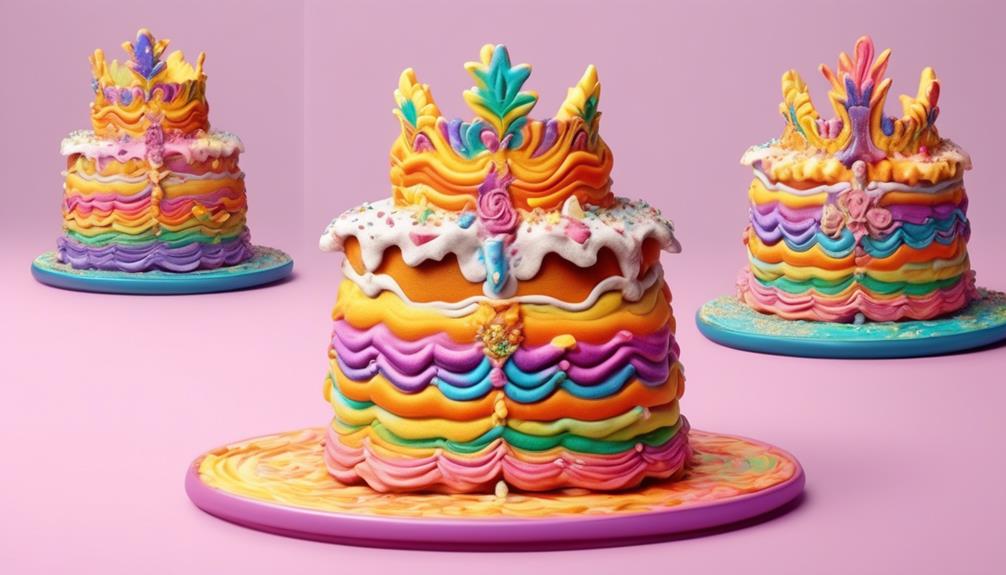
King's Cake in popular culture has sparked a growing interest in creating and sharing delightful King's Cake recipes and tips for enthusiasts to enjoy. Here are some tips and ideas for making the perfect King's Cake:
- Flavorful Variations: Experiment with different king's cake flavors such as traditional cinnamon, creamy praline, or even a decadent chocolate filling. Get creative with the flavors to cater to diverse preferences and surprise your guests with a unique twist on this classic treat.
- Creative Decorations: Elevate the visual appeal of your King's Cake by adding creative decorations. Consider using colorful icing, edible gold or silver dust, or even incorporating the colors of Mardi Gras – purple, green, and gold. These decorative elements not only enhance the cake's appearance but also add an extra layer of excitement to the overall experience.
- Homemade Dough: For an authentic touch, consider making the King's Cake dough from scratch. The homemade dough adds a level of richness and freshness that store-bought dough simply can't match.
- Sharing the Tradition: Don't forget the most crucial ingredient – sharing! Whether it's with family, friends, or colleagues, the joy of the King's Cake tradition lies in coming together and celebrating. So, bake a little extra to share the tradition with others and spread the joy of this time-honored treat.
Frequently Asked Questions
What Are the Potential Health Risks Associated With Consuming a King's Cake, Especially for Individuals With Dietary Restrictions or Allergies?
Potential health risks associated with consuming a king's cake, especially for individuals with dietary restrictions or allergies, include allergic reactions to ingredients like nuts or dairy. It's crucial to check the cake's ingredients carefully before consumption.
For those with dietary restrictions, the high sugar and fat content in the cake may pose challenges. It's important to be mindful of consumption restrictions and seek alternative options to enjoy the tradition without compromising health.
Are There Any Superstitions or Beliefs Surrounding the Consumption of a King's Cake, and What Are the Associated Rituals or Customs?
Superstitions and beliefs intertwine with the consumption rituals and customs of the King's Cake, adding an enchanting layer to the tradition. Our interactions with this delicacy can be steeped in cultural variations and serve as a symbol of unity and celebration.
Additionally, serving etiquette and special occasions adaptations further enrich the experience. It's truly fascinating how this pastry carries such deep significance and meaning across different communities.
How Does the Tradition of the King's Cake Vary Among Different Socioeconomic Classes or Cultural Groups?
Socioeconomic differences and cultural variations shape the tradition of the king's cake. Among various groups, the way the cake is made, its ingredients, and the significance of finding the hidden trinket can vary.
In some communities, elaborate king's cake parties are thrown, while in others, it's a more intimate family affair. The cake's design and size may also reflect these differences.
These distinct traditions add richness and diversity to the celebration of the king's cake.
Are There Any Specific Guidelines or Etiquette for Serving and Sharing a King's Cake at Social Gatherings or Events?
Serving etiquette and sharing guidelines for a King's cake are important in maintaining the tradition's spirit. It's customary to hide a small figurine or bean inside the cake and whoever finds it gets crowned 'king' or 'queen' for the day.
When serving, the host should explain the tradition and warn guests about the hidden token. Then, the cake is cut with each person receiving a slice until the hidden piece is found.
Can the King's Cake Be Adapted for Special Occasions or Holidays Outside of the Traditional Epiphany and Mardi Gras Celebrations?
Absolutely! Adapting traditions is a beautiful way of celebrating diversity.
Whether it's a birthday, a wedding, or a cultural festival, the King's Cake can be infused with new meanings and flavors, honoring different traditions and bringing people together in delightful ways.
It's a heartwarming tribute to the richness of our shared experiences.
Embracing the King's Cake in diverse contexts is a reflection of our collective desire to celebrate unity in all its beautiful forms.
Conclusion
In conclusion, the tradition of the king's cake is a rich and fascinating part of cultural celebrations. From its ancient origins to its modern-day customs, the cake holds a special place in the hearts of many.
Its symbolism, hidden trinkets, and royal court traditions make it a truly unique and cherished dessert.
So, next time you indulge in a slice of king's cake, remember that you're participating in a time-honored tradition that's fit for royalty!
- About the Author
- Latest Posts
Introducing Ron, the home decor aficionado at ByRetreat, whose passion for creating beautiful and inviting spaces is at the heart of his work. With his deep knowledge of home decor and his innate sense of style, Ron brings a wealth of expertise and a keen eye for detail to the ByRetreat team.
Ron’s love for home decor goes beyond aesthetics; he understands that our surroundings play a significant role in our overall well-being and productivity. With this in mind, Ron is dedicated to transforming remote workspaces into havens of comfort, functionality, and beauty.
-

 Vetted4 weeks ago
Vetted4 weeks ago15 Best Contact Paper for Kitchen Cabinets to Elevate Your Home Decor
-

 Vetted2 weeks ago
Vetted2 weeks ago15 Best Poe Cameras for Home Security – Reviews & Buying Guide
-

 Vetted4 weeks ago
Vetted4 weeks ago15 Best Drain Snakes to Unclog Your Pipes Like a Pro
-

 Beginners Guides1 week ago
Beginners Guides1 week agoI Inhaled Vinegar Fumes
-

 Beginners Guides3 weeks ago
Beginners Guides3 weeks agoSwinger Porch Light Color
-

 Mardi Gras Decoration4 weeks ago
Mardi Gras Decoration4 weeks agoWhy Does Hobby Lobby Not Do Mardi Gras?
-

 Vetted2 weeks ago
Vetted2 weeks ago15 Best Blinds for Bathroom Windows to Enhance Privacy and Style
-

 Vetted4 weeks ago
Vetted4 weeks ago15 Best Rat Traps to Safely and Effectively Rid Your Home of Rodents



















![Best Nautical Bathroom Accessories for a Seafaring Home [2024] 376 81qrq833mjL](https://byretreat.com/wp-content/uploads/2023/11/81qrq833mjL-400x240.jpg)
![Best Nautical Bathroom Accessories for a Seafaring Home [2024] 377 81qrq833mjL](https://byretreat.com/wp-content/uploads/2023/11/81qrq833mjL-80x80.jpg)

![Best 42 Inch Ceiling Fans Under $100: Affordable and Effective Solutions [2024] 378 61FOGKbhRiL](https://byretreat.com/wp-content/uploads/2023/11/61FOGKbhRiL-80x80.jpg)

